Wagyu Butcher (Torrance, CA)
Wagyu Butcher
2104 Artesia Blvd, Torrance, CA 90504
310-483-1530
www.instagram.com/wagyu_butcher_la/
Sun 04/20/2025, 07:30p-10:10p

I'm always on the lookout for new yakiniku-ya, and a recent entrant into the scene is the straightforwardly-monikered Wagyu Butcher, which opened in early November last year. The restaurant is spearheaded by Toshinori Hayakawa (早川宗徳) and Takatoshi Kano (家納孝敏), alumni of the Gyu-Kaku chain and part of the leadership team at Dining Innovation, a Japanese hospitality group that operates nearly 500 eateries. To run the kitchen, they've brought on board Executive Butcher Takeshi Yamakawa, an industry veteran who operates two yakiniku spots and a yakitori-ya in Osaka.
About the Chef: Yamakawa Takeshi (山川剛史) originally hails from Fukushima, the son of rice farmers who developed an interest in food early on. After finishing high school at age 18, he moved to Osaka and attended the Tsuji Culinary Institute (辻調理師専門学校), during which time he worked at a local counter-service okonomiyaki joint and fell in love with the customer interaction aspect of running a restaurant. Following, he spent three years at a barbecue-slash-yakitori spot, and it's here where he really honed his butchery skills.
In July 2009, via his company Mochitsumotaretsu (株式会社もちつもたれつ), Yamakawa-san took over Dengeki Horumon Tsugie (電撃ホルモン ツギエ), a yakiniku restaurant in Osaka's Tenma neighborhood that was initially started in September 2007 by Genki Factory (元気ファクトリー). The tachigui-style (standing-only) eatery began gaining more and more customers, and its success allowed the Chef to open a second location by the name of Nikukurai Horumon Susumu (肉喰ホルモンすすむ) in nearby Tenroku in May 2013. This was followed by a yakitori place in Kyobashi called Akadori Haruka (赤鶏はるか) in April 2016, and from what I understand, all three businesses are still operational.
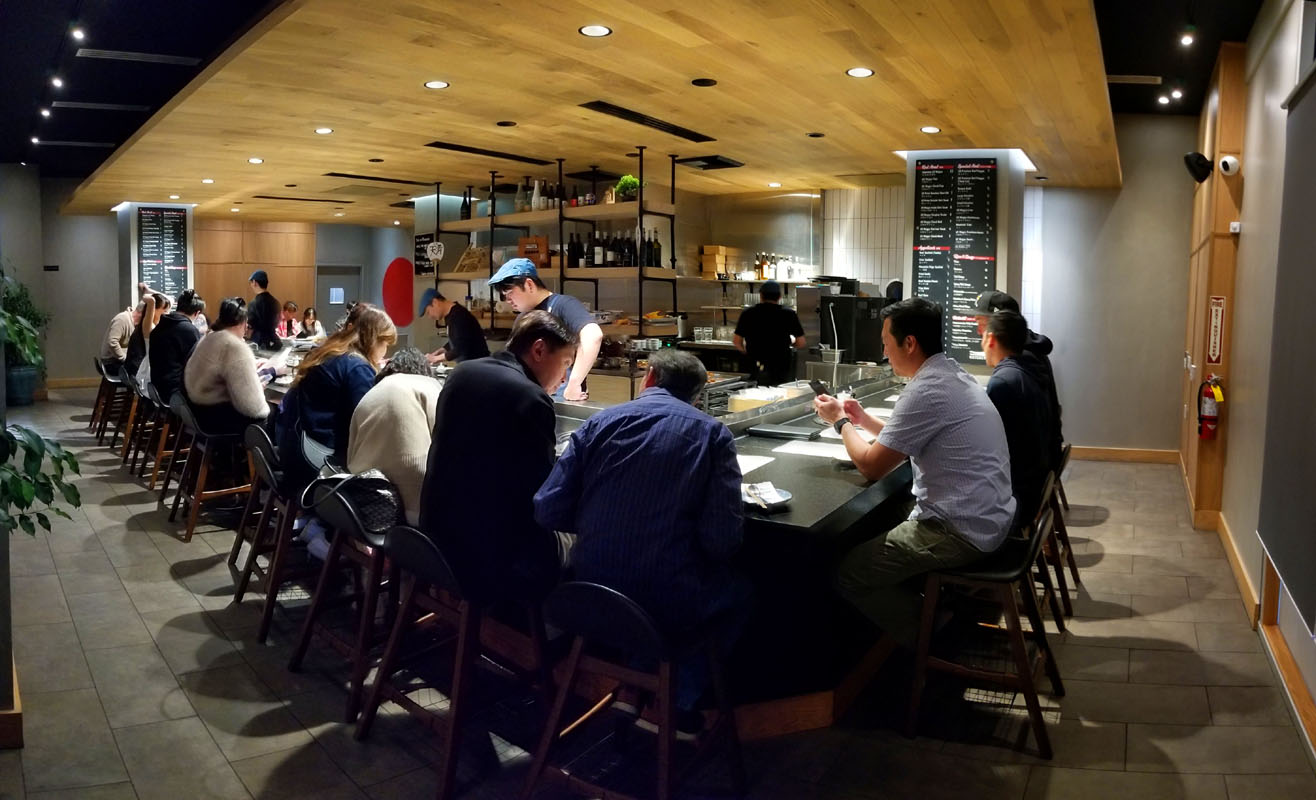
Wagyu Butcher takes over a newly-built storefront at Van Art Square, the same strip mall that's home to Hasu and Curryfornia. The restaurant comprises one large U-shaped counter surrounding the kitchen; 10 grills are installed, thus allowing up to 20 guests to dine.
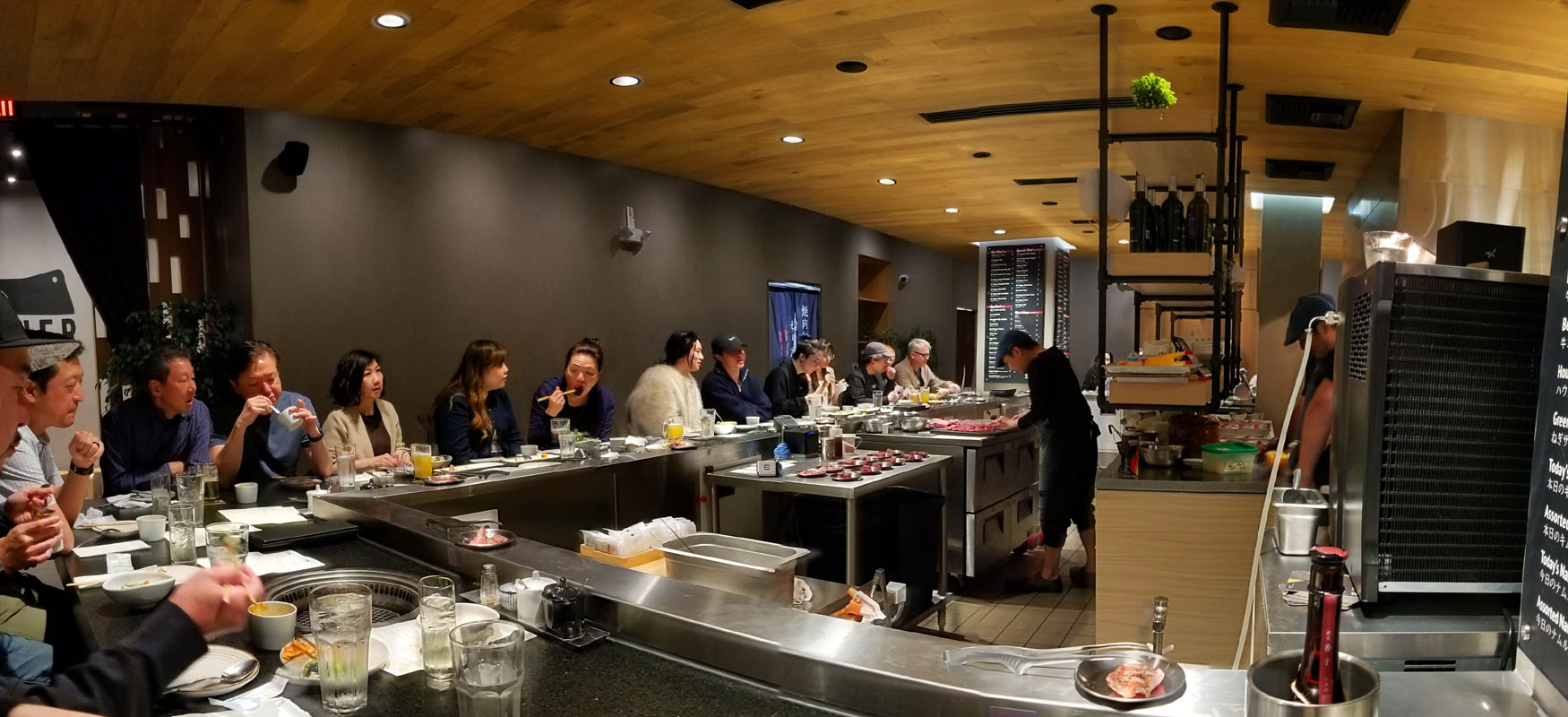
Shown above is my view from the right-most seat at the bar. If you're wondering what's written on the noren, it's: 焼肉は 切りたてが 断然らまい ("freshly cut yakiniku is definitely the best").

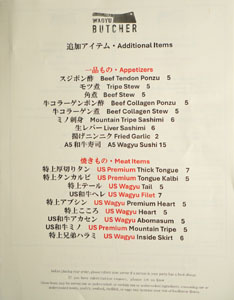
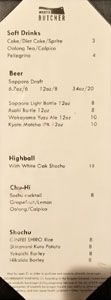
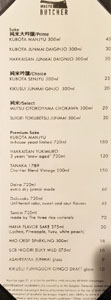
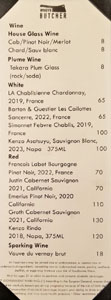
As for Wagyu Butcher's menu, Takeshi-san offers a $70 Butcher's Omakase (ブッチャーズおまかせ) and a $50 Tenma Omakase (天満おまかせ), along with optional à la carte supplements. To drink, there's a small selection of sake, a compact wine list, a smattering of beer, and sundry variations of shochu. Corkage was $25 a pop. Click for larger versions.

1: Today's Kimchee | キムチ盛合せ
The first of four zensai courses was an assortment of kimchi. I began with the tomato, which featured this familiar, almost Chinese-y spicing that I really enjoyed. The napa cabbage was more classic in terms of taste, with a somewhat drier consistency than usual. Last up was the celery, which had its bitter, vegetal qualities well-tempered by a chile-fueled heat.
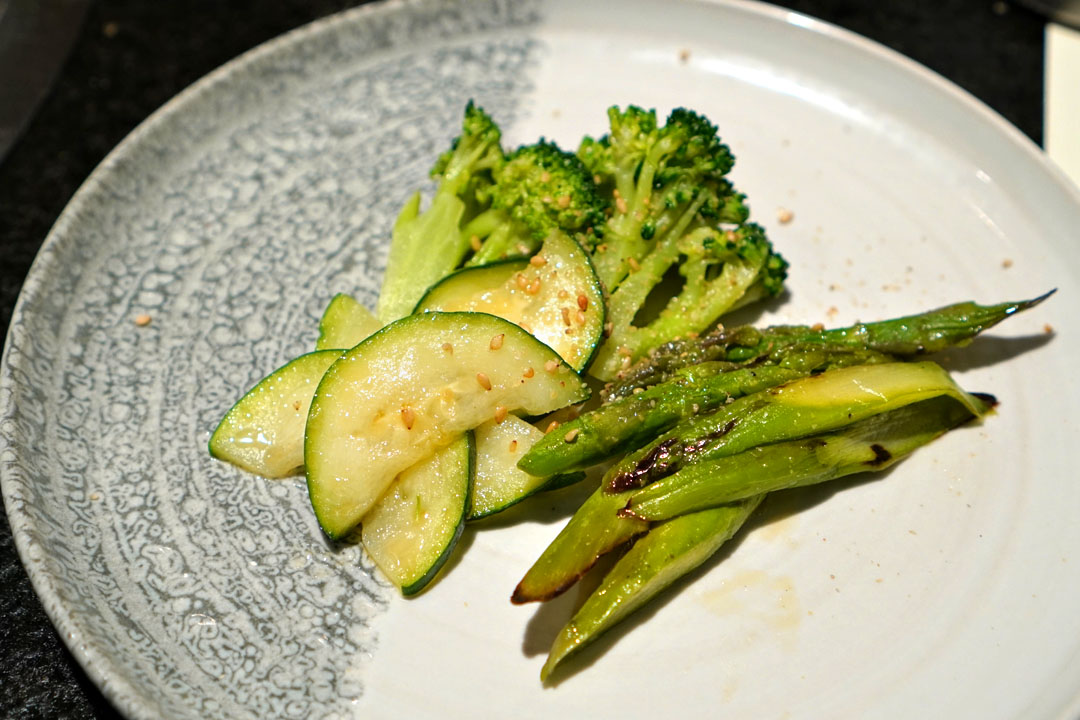
2: Today's Vegetable | ナムル盛合せ
Our namuru moriawase selection also fit the bill, and I especially enjoyed how the veggies played with the overtly nutty, sesame-powered flavors in the dish.
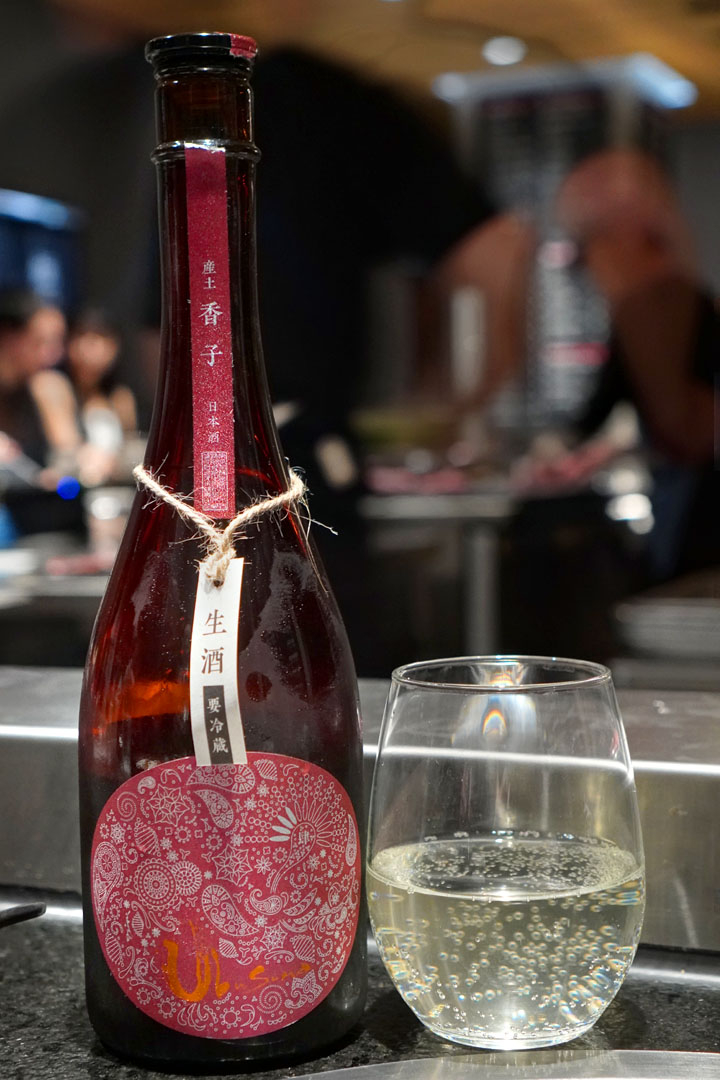
We BYOB'd tonight, and first to drink was the 2024 Hananoka Ubusuna Kabashiko Shinojo Namazake (花の香 産土 香子 四農醸 生酒), a kimoto-style brew from Kumamoto Prefecture, made from a recently-revived type of rice grown in the Kikuchi River basin. The sake smelled sweet and rice-forward, with a real freshness to go along with hints of minerality and white fruits. On the palate, this was fizzy and refreshing, its ricey sweetness recalling pastry dough at times while being joined by a bitter backing and a pervasive acidity. Do note that I actually drank this bottle's two sister sakes at Tonchinkan back in January, and this was probably my favorite of the three.
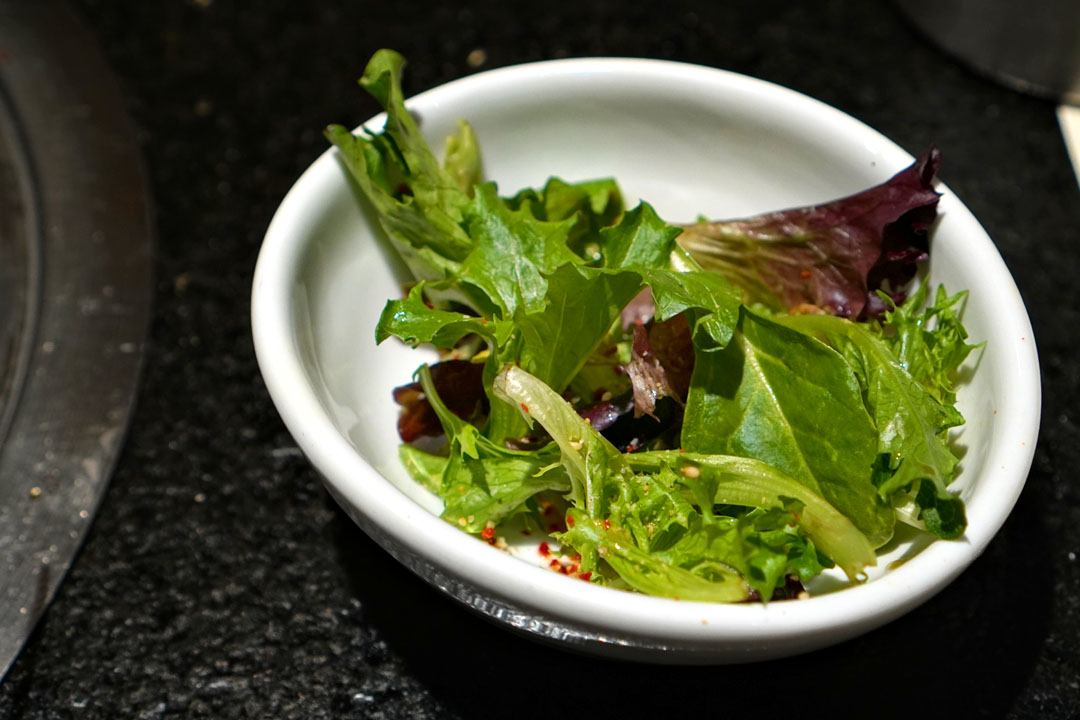
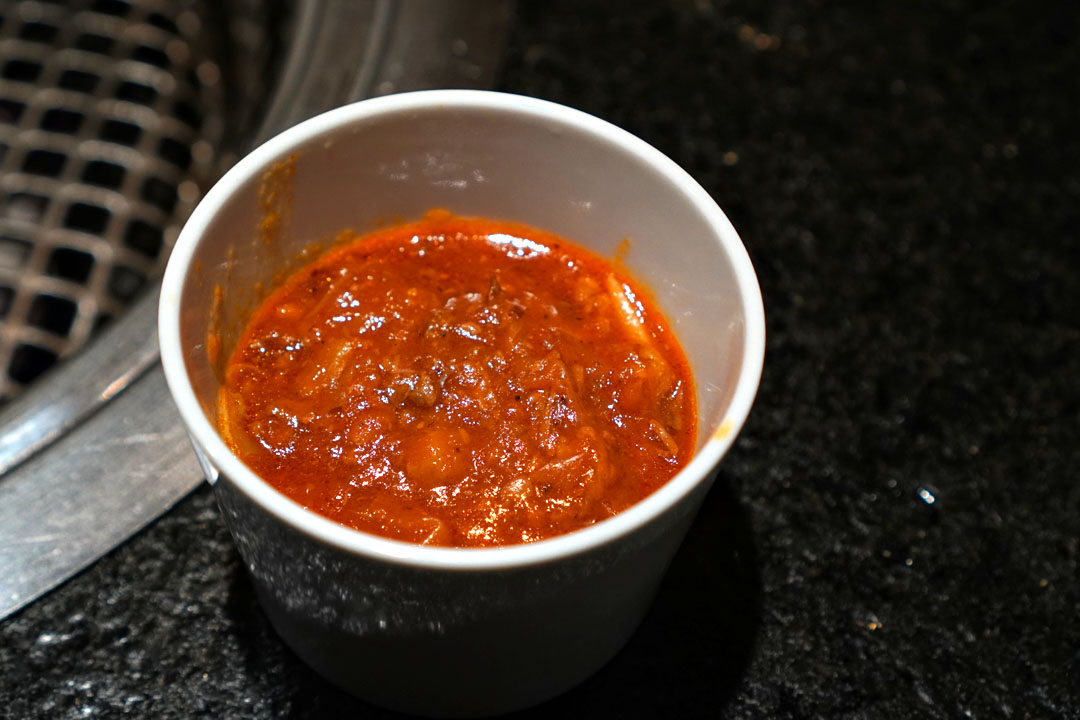
3: House Salad & Today's Soup | サラダ&スープ
Next came a bright, bitter salad, though one that could've used a bit more dressing. More interesting was the beef tendon soup, which paired the meat with a bevy of sweet, tangy, tomato-ish flavors.
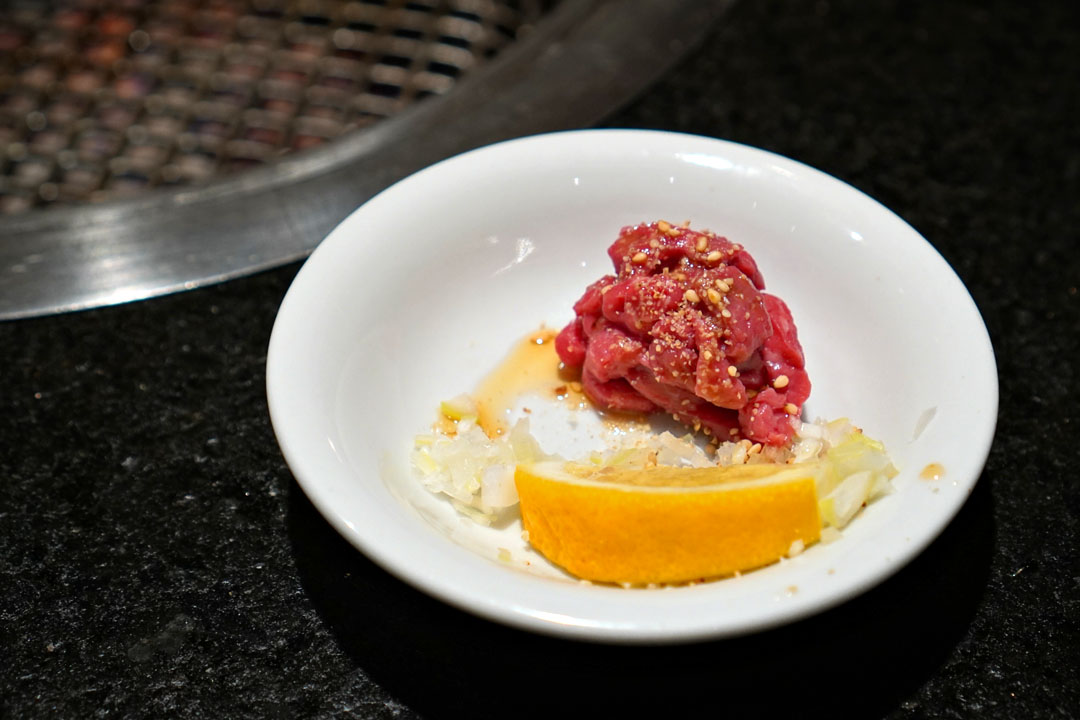
4: Shio Beef Sashimi | 塩ユッケ
The shio yukke delivered, the mildly seasoned, slightly chewy beef melding well with the zestiness of chopped onion, all while that lemon imparted a sour twang.
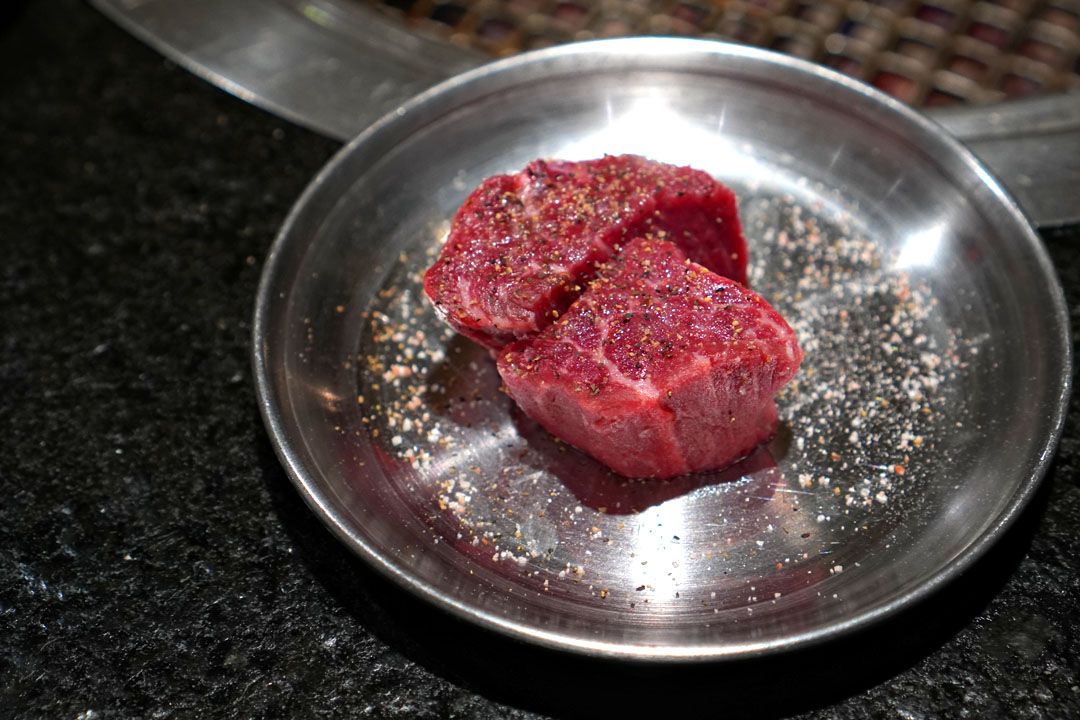
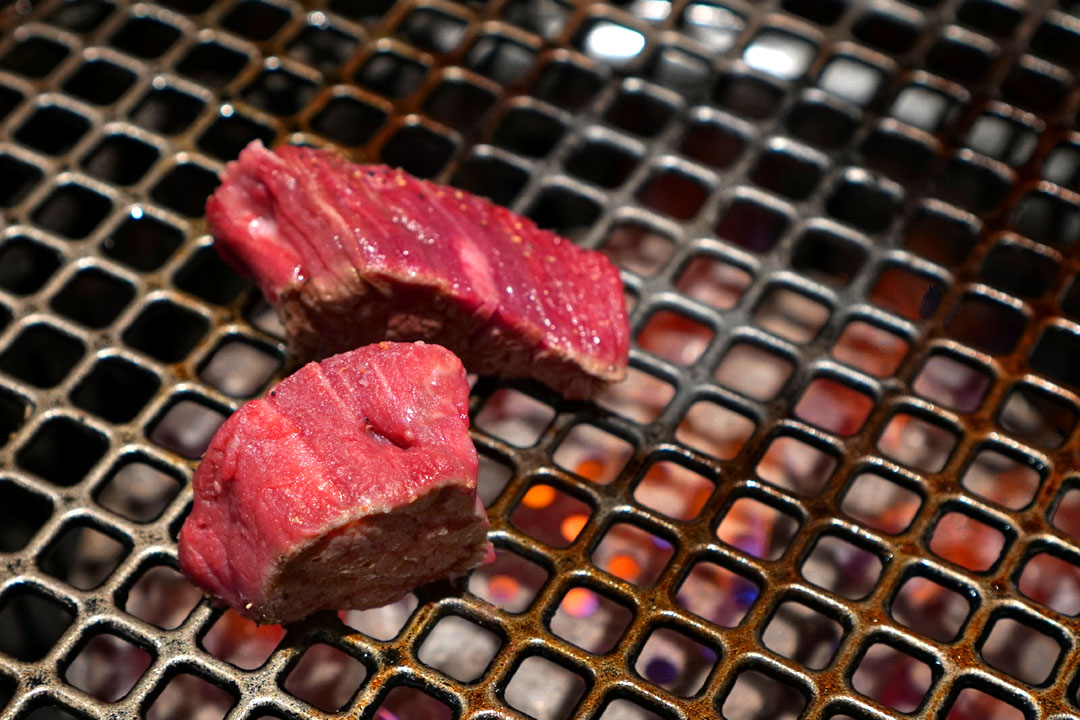
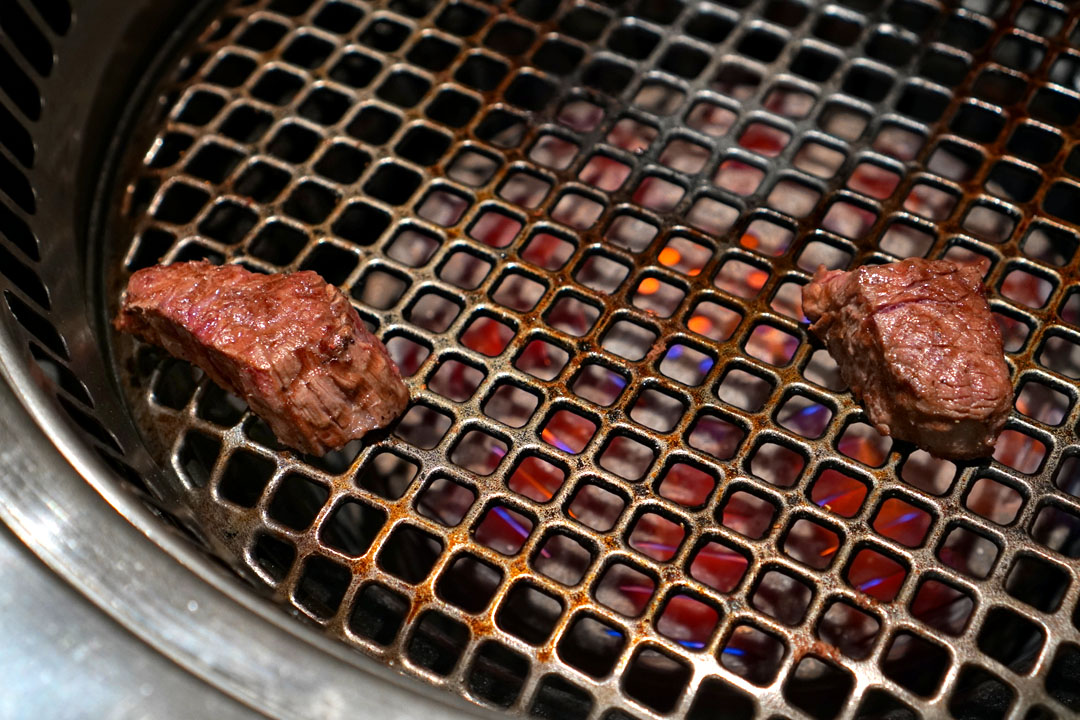
5a: Lemon • US Wagyu Filet | レモン • US和牛ヘレ
At this point, it was time for the oniku portion of our dinner to commence, and up first was the hire, a supple, fine-grained cut with the classic, subdued tastes that you'd expect from tenderloin.
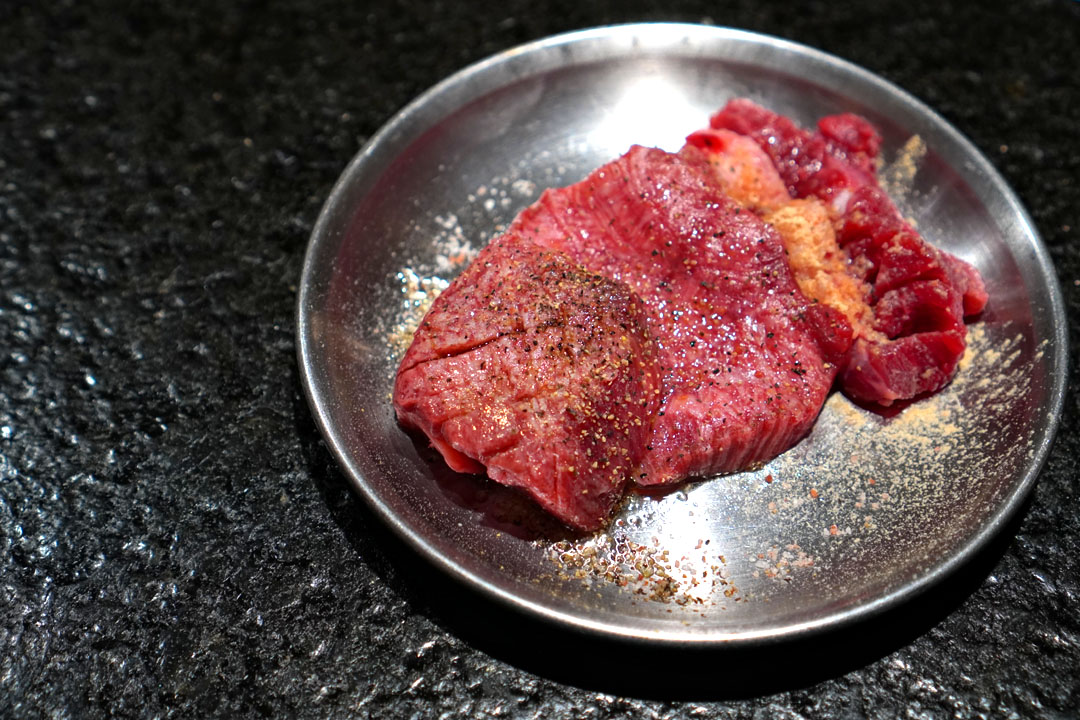
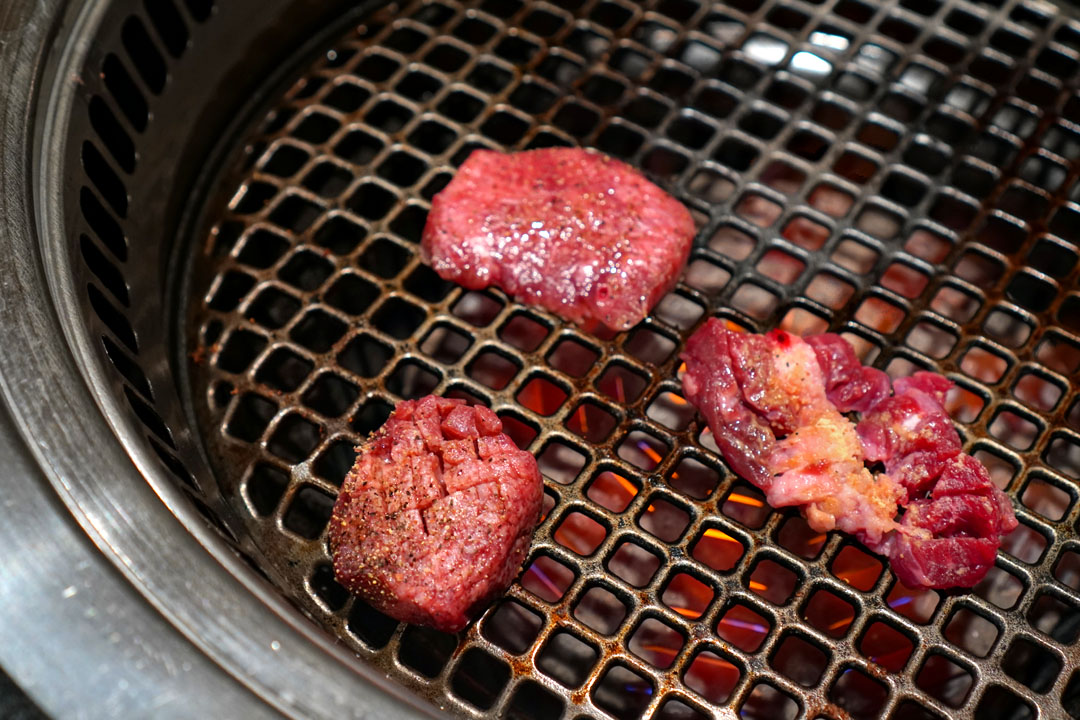
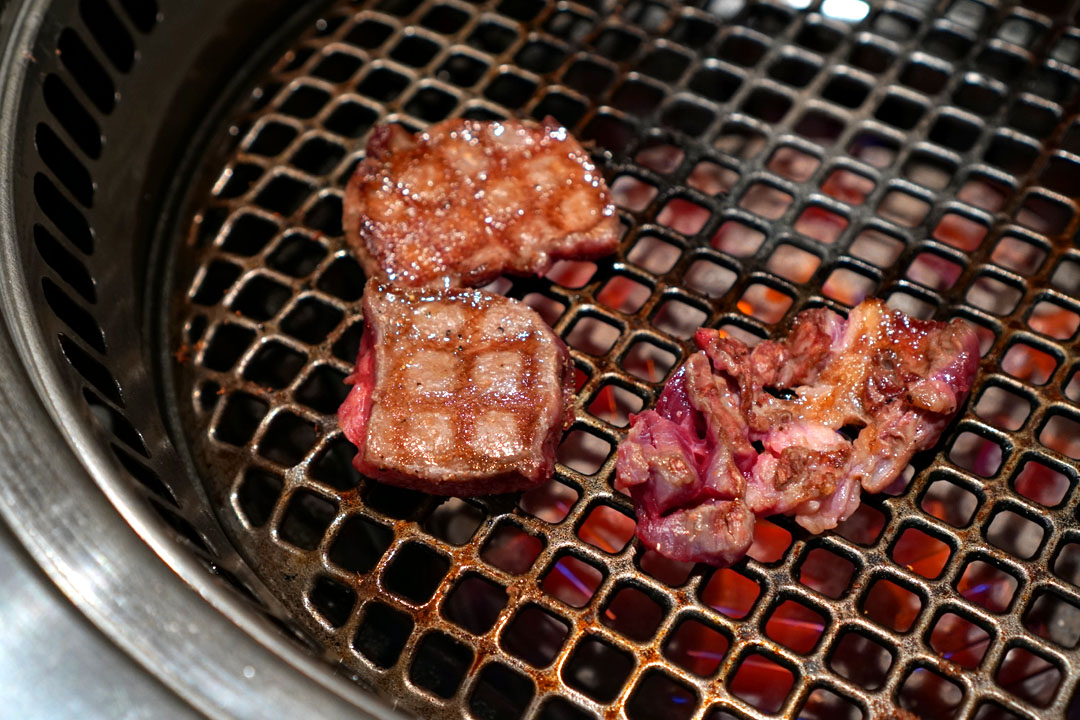
5b: Lemon • 3 Beef Tongues (Thin, Thick & Tongue Kalbi) | レモン • 特上牛タン3種(牛タン, 厚切りタン, タンカルビ)
Along with the filet above, we were given a trio of gyutan. I began with the atsu-kiri, which was great texturally, with an almost silky, "snappy" mouthfeel and a restrained beefiness. The standard tongue, meanwhile, showed off a more assertive consistency, along with a richer flavor profile. Finally, the karubi was the most unexpected of the threesome. Taken from the underside of the tongue, it was easily the chewiest of the bunch, but also the saltiest and the savoriest.
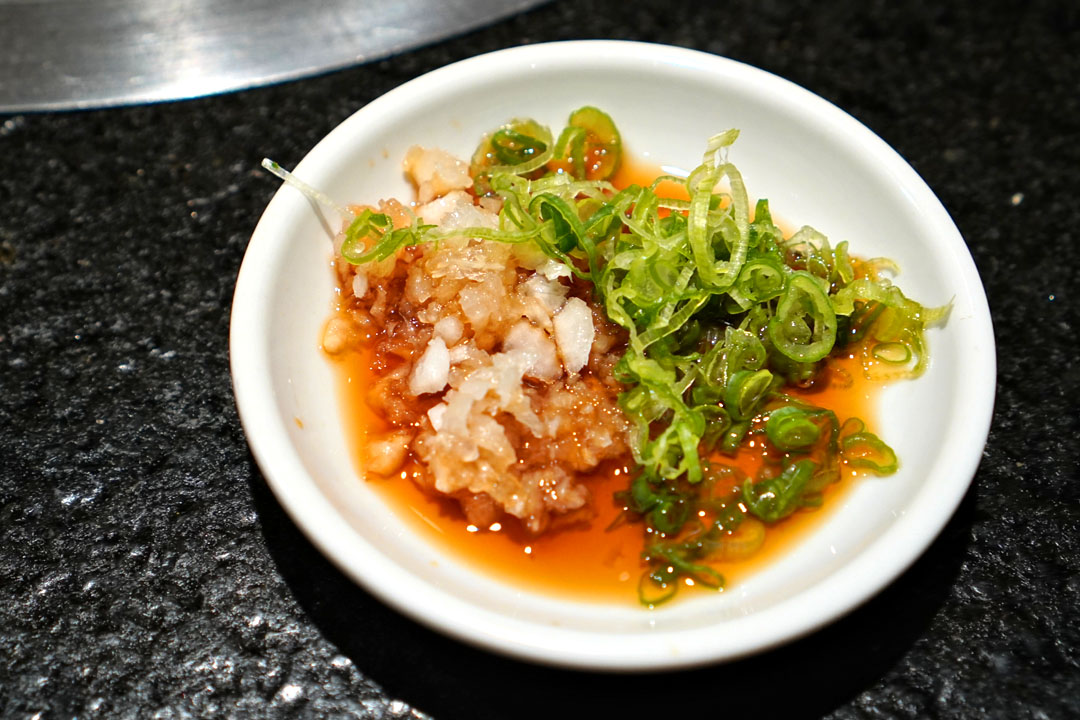
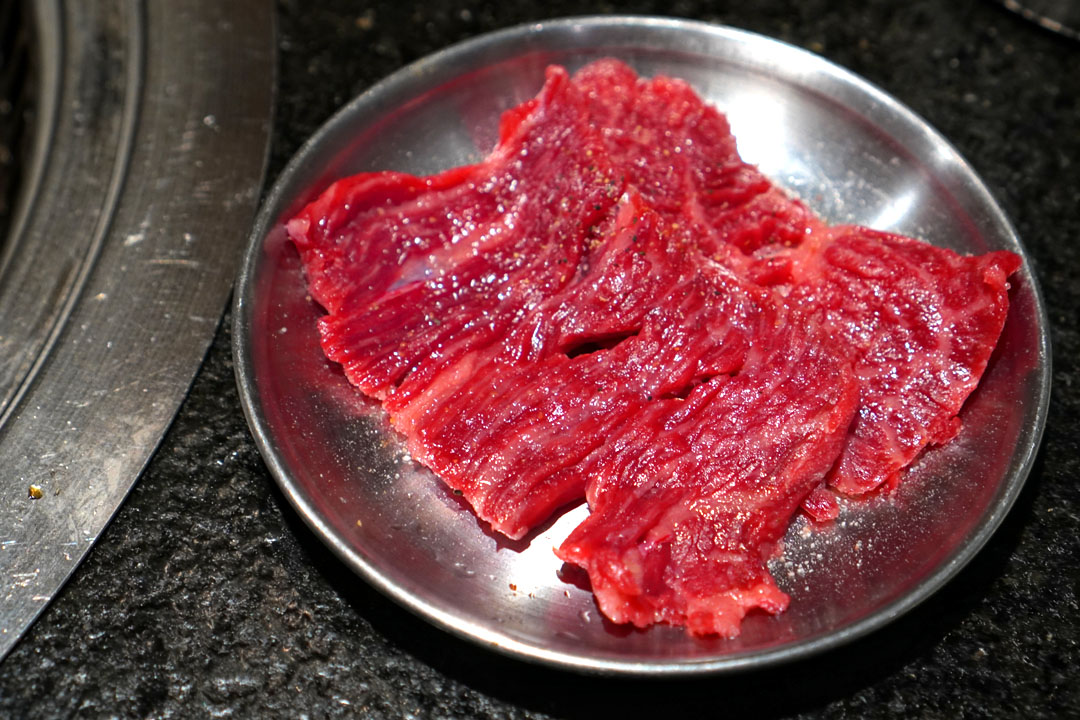
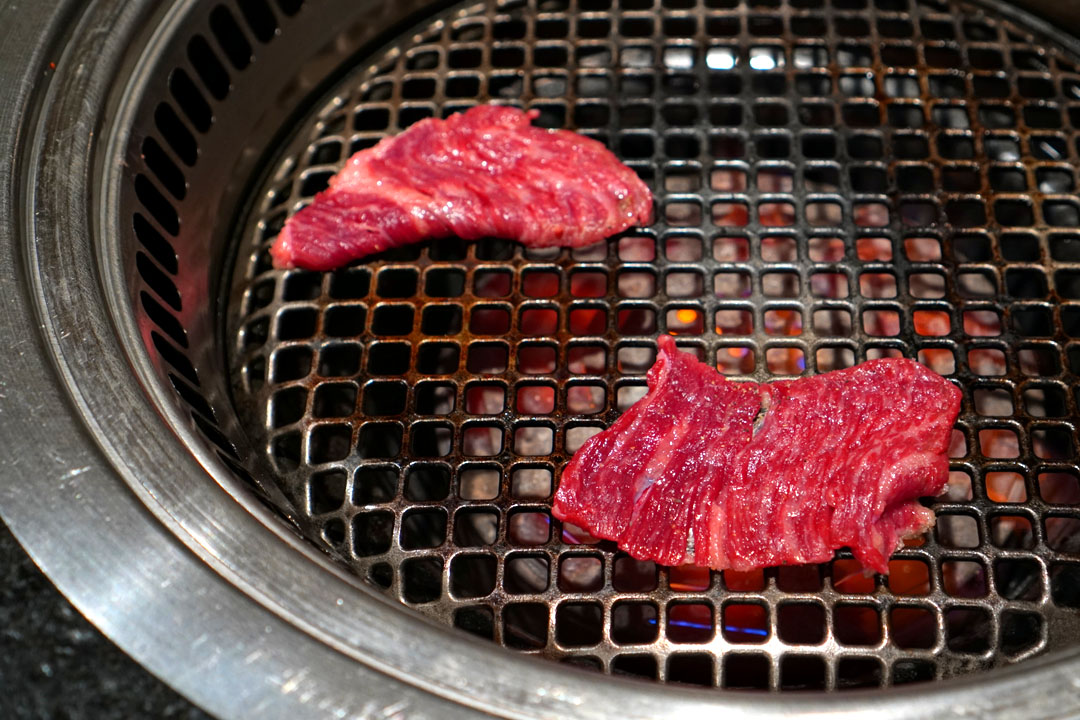
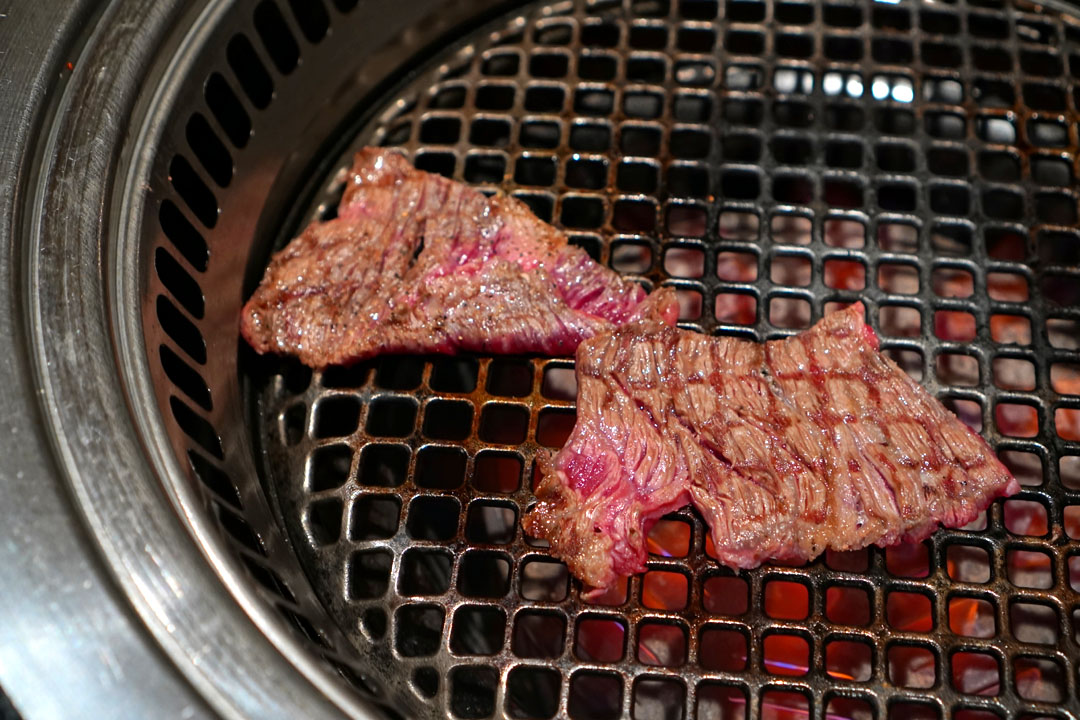
6: Ponzu • US Wagyu Chuck Flap | ポン酢 • US和牛ロース
The rosu was perhaps the most balanced cut of beef we had tonight, both in terms of taste and texture, and made a whole lotta sense with a dip into that tangy ponzu.
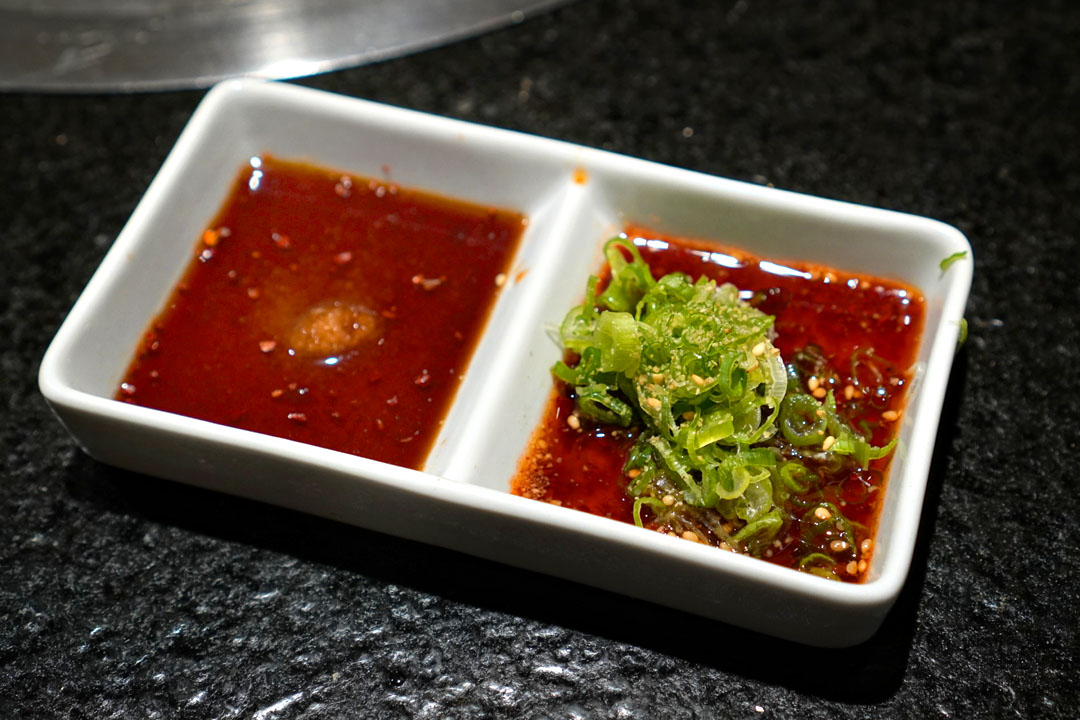

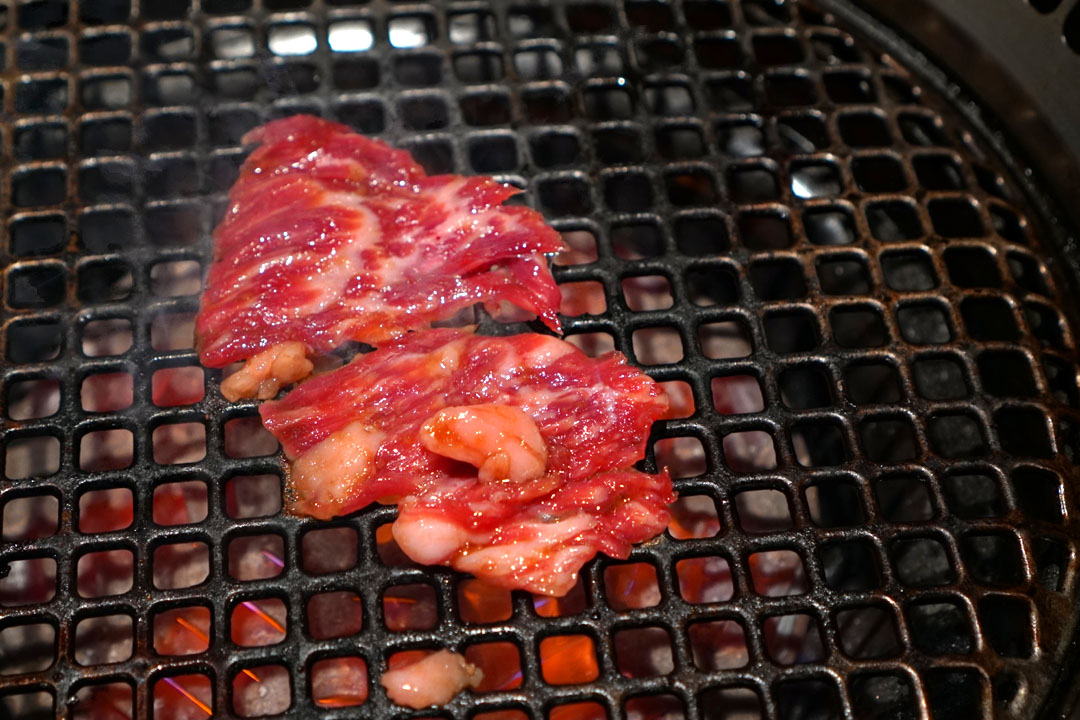
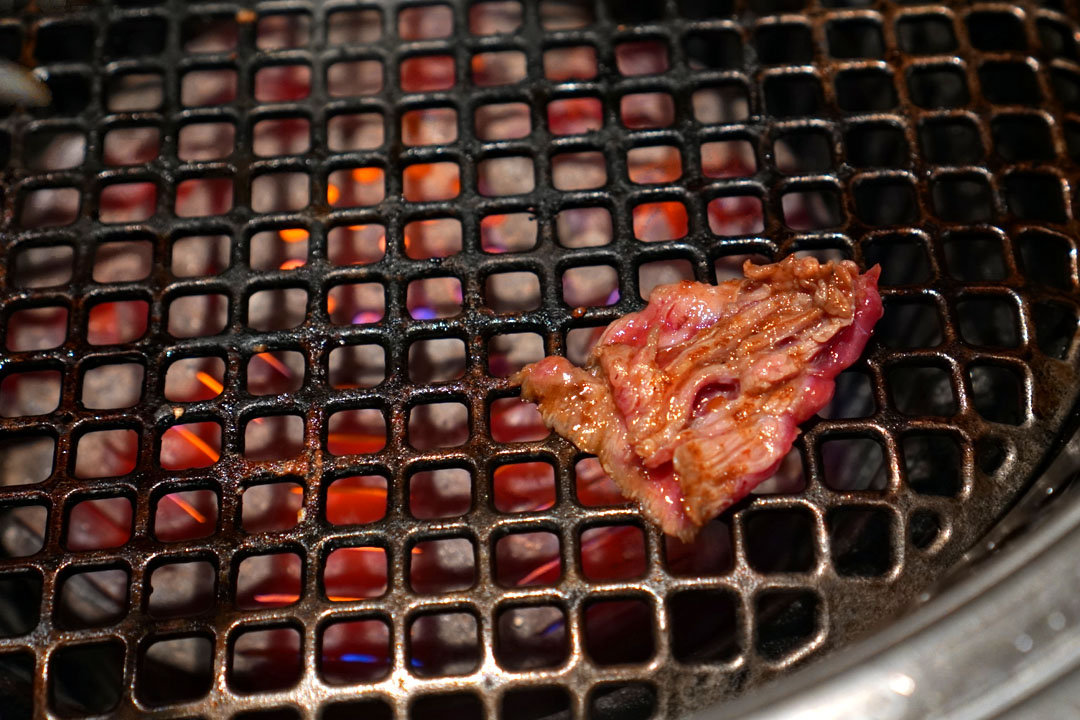
7: Sweet Soy • US Prime Short Rib | タレ • 特上カルビ
The tokujo karubi displayed a bit of chew, and definitely possessed a palpable sweetness, but fortunately one that never got overwhelming. The galbi was accompanied by two types of tare. The Tokyo-style was meant to be sweeter, and seemingly emphasized the smokiness of the beef. On the other hand, the Osaka-style sauce was described as being saltier, and appeared to highlight the interplay between the sweetness of the meat and the green onion.

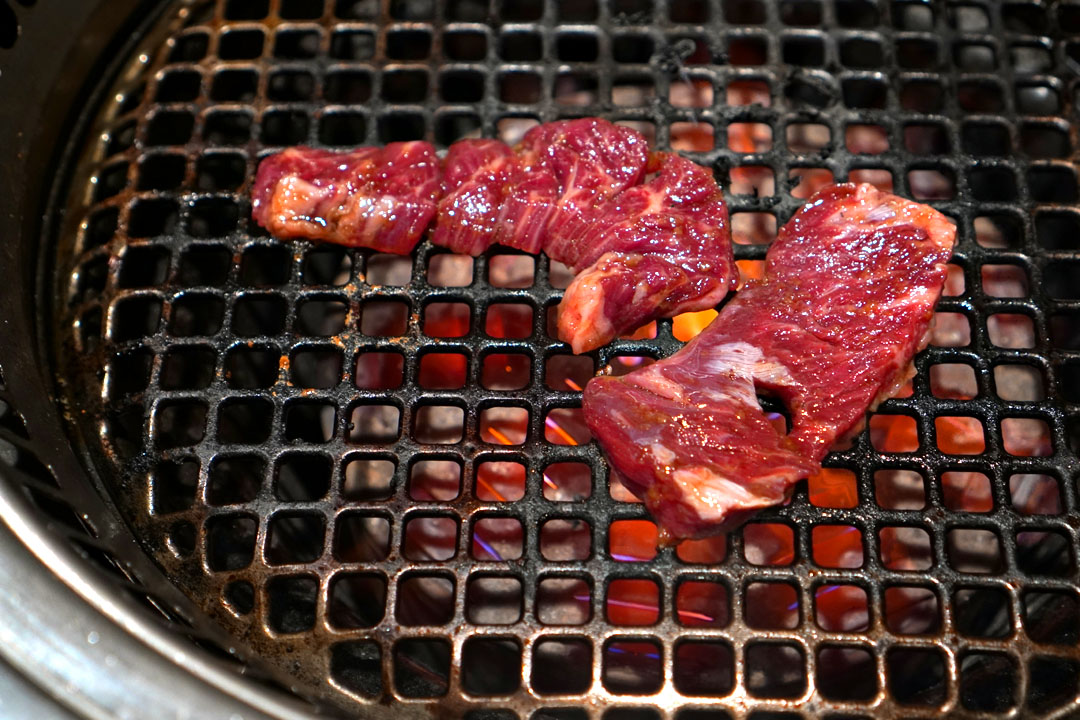
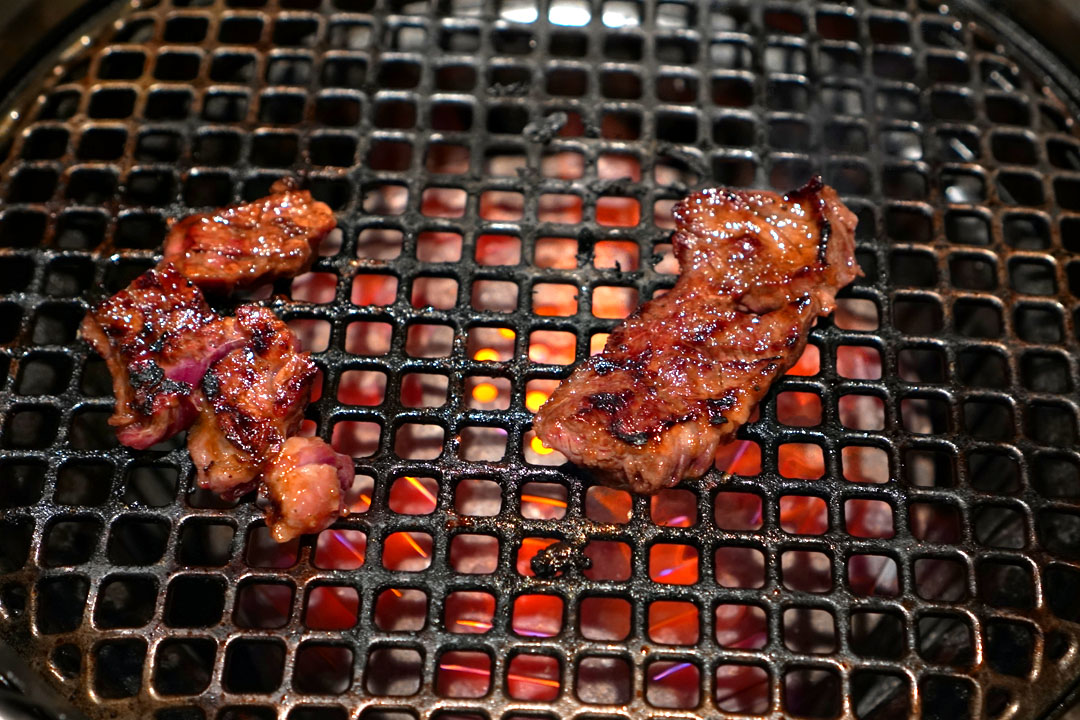
8: Sweet Soy • US Prime Outside Skirt | タレ • 特上ハラミ
Our tokujo harami was probably the most intriguing cut of the night in terms of texture, while the skirt steak's sophisticated display of umami was joined by a slight sweetness that I didn't mind.
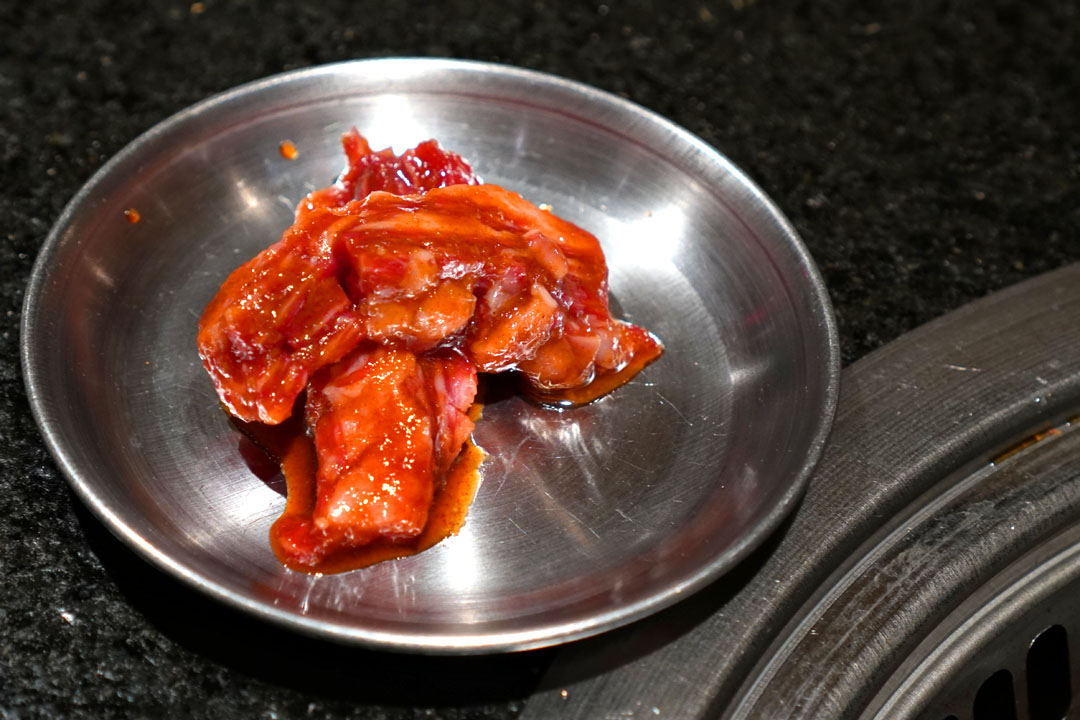
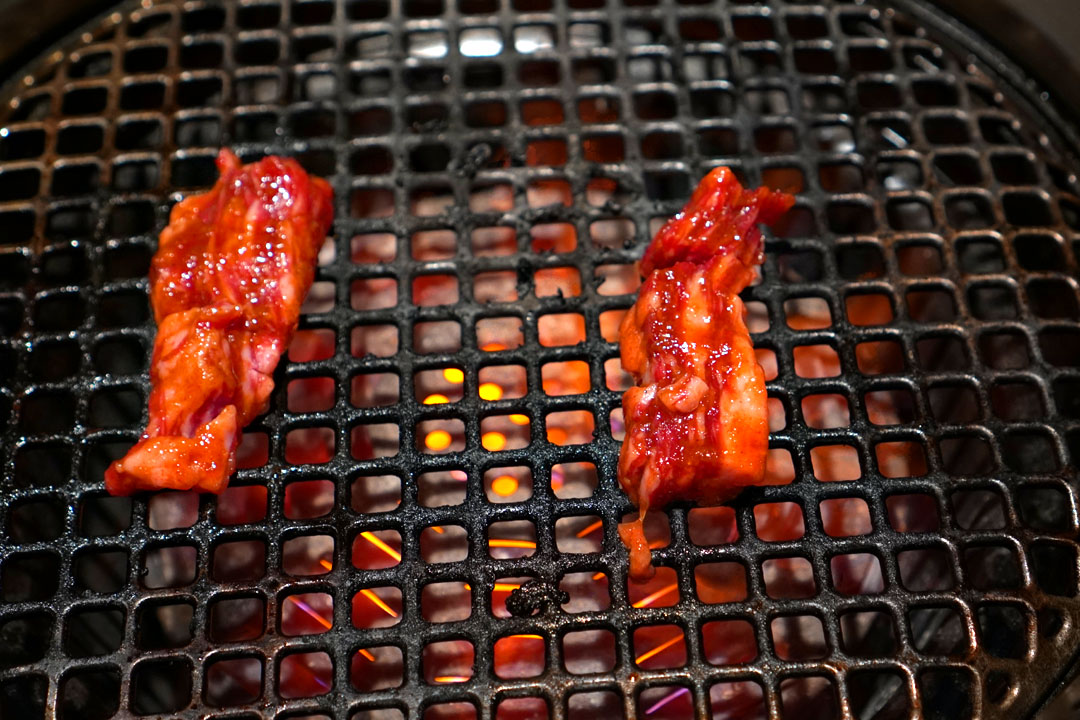

9a: Miso • US Wagyu Inside Skirt | 味噌 • US和牛兄弟ハラミ
Compared to the skirt steak above, the kyodai harami was an altogether different experience: a much fattier, chewier cut with a more apparent, miso-boosted sweetness.
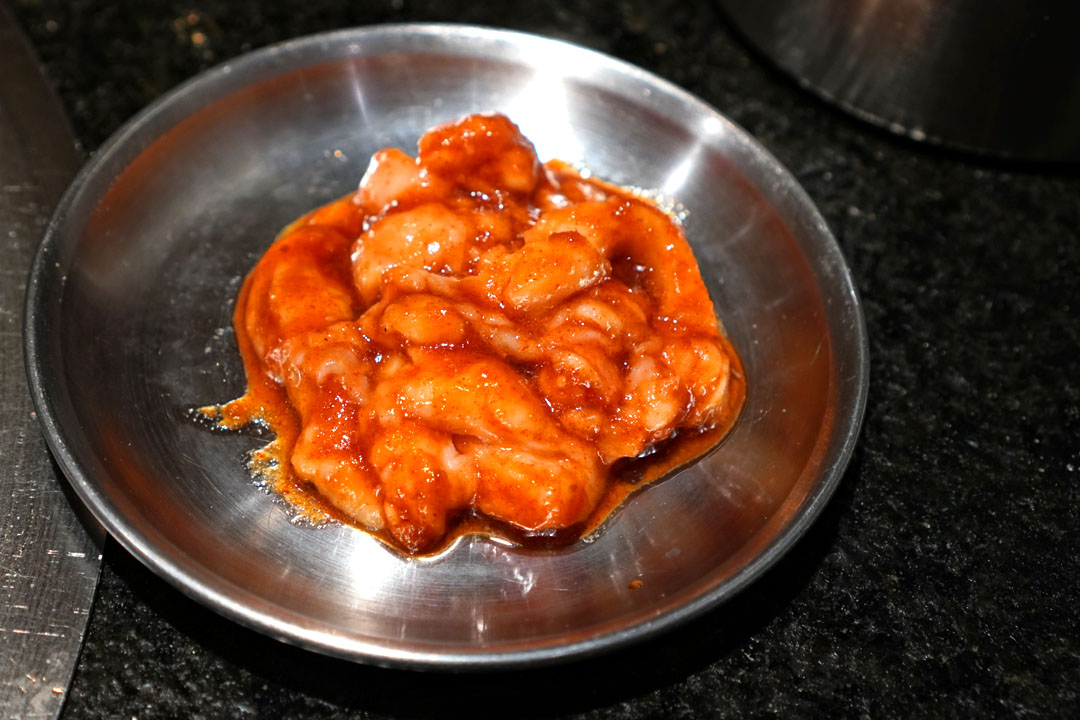
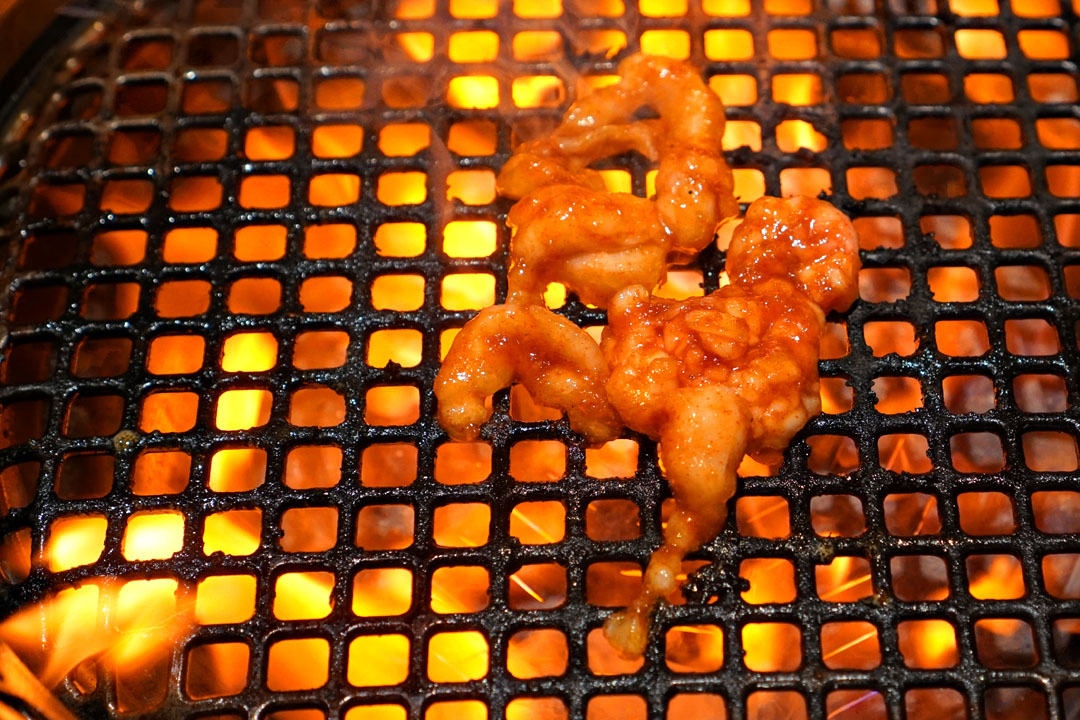
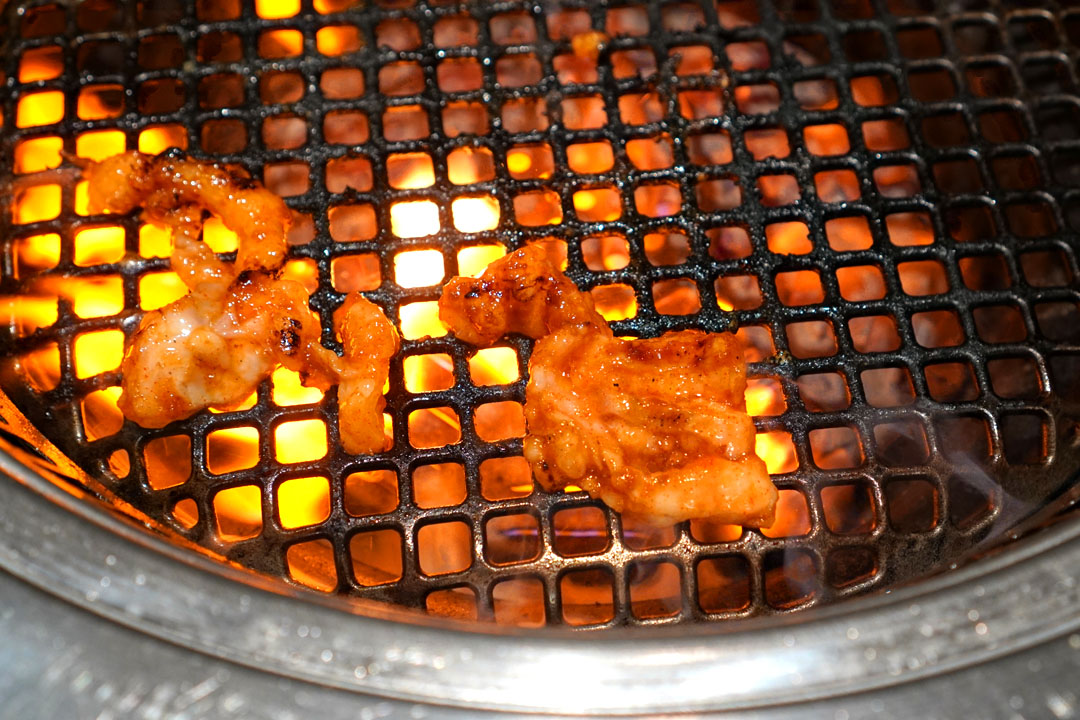
9b: Miso • Large Intestine | 味噌 • ホルモン(大腸)
The daicho marked the first appearance of horumon in our meal. The offal demonstrated an agreeably tender-yet-chewy texture, while its sweetness married well with all the smoke and sear happening.
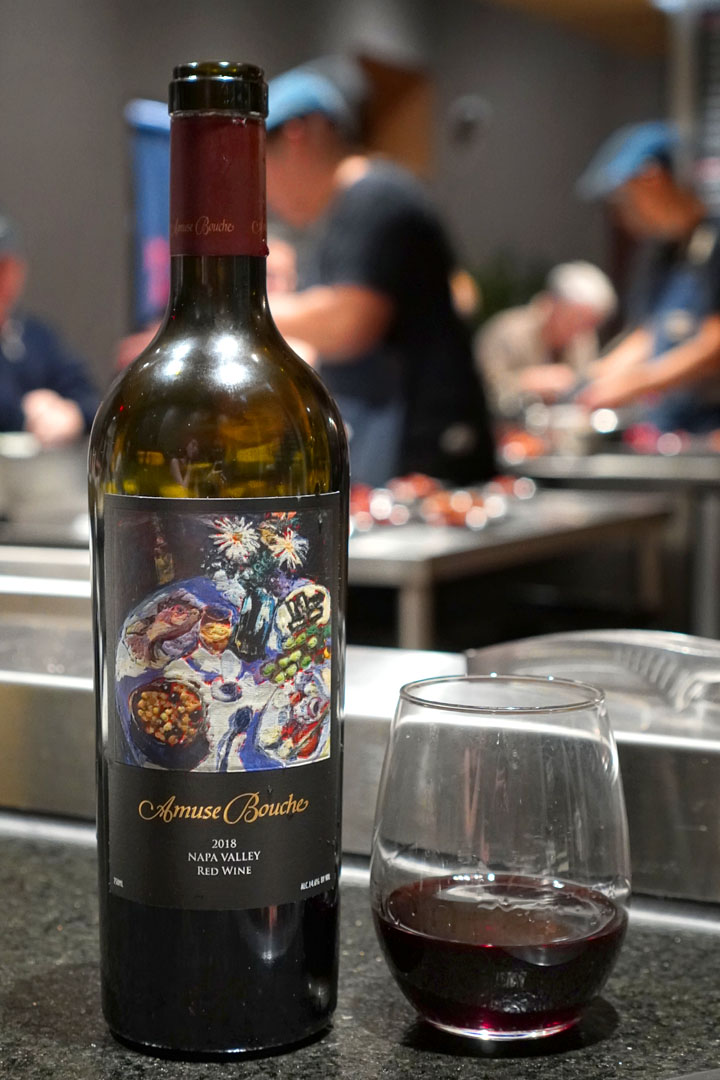
The evening's second BYO bottle was the 2018 Amuse Bouche, a Pomerol-inspired Napa Valley red blend comprised of 92% Merlot and 8% Cabernet Franc. On the nose, the wine conveyed an amalgam of jammy berries and blue fruits, overarched by layers of florals and hints of baking spice. Taking a sip, I found this on the rounder side, its plethora of cool, dark berry notes countered by mineral elements and traces of peppery spice. An apt pairing to all the meat we were having, to be sure.
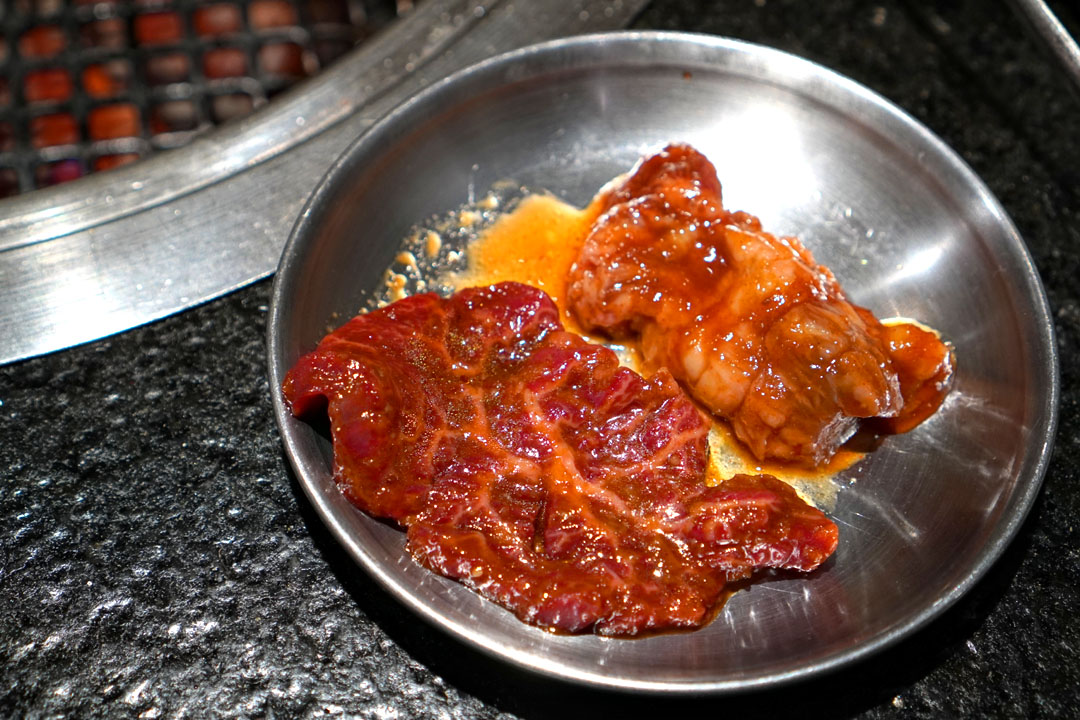
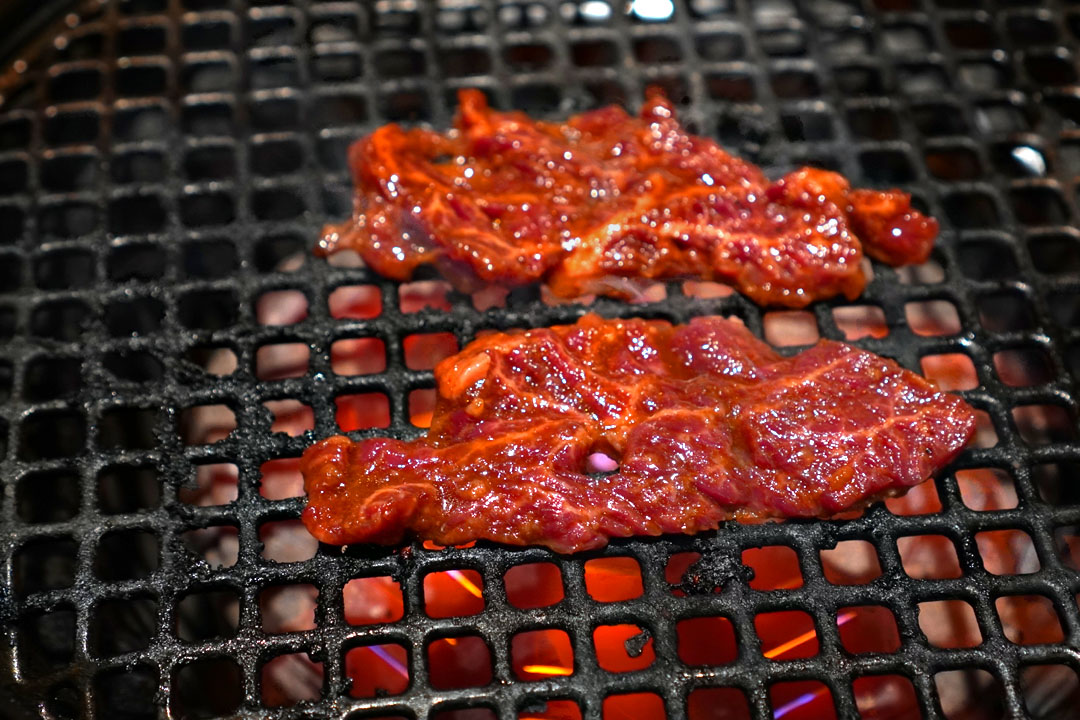
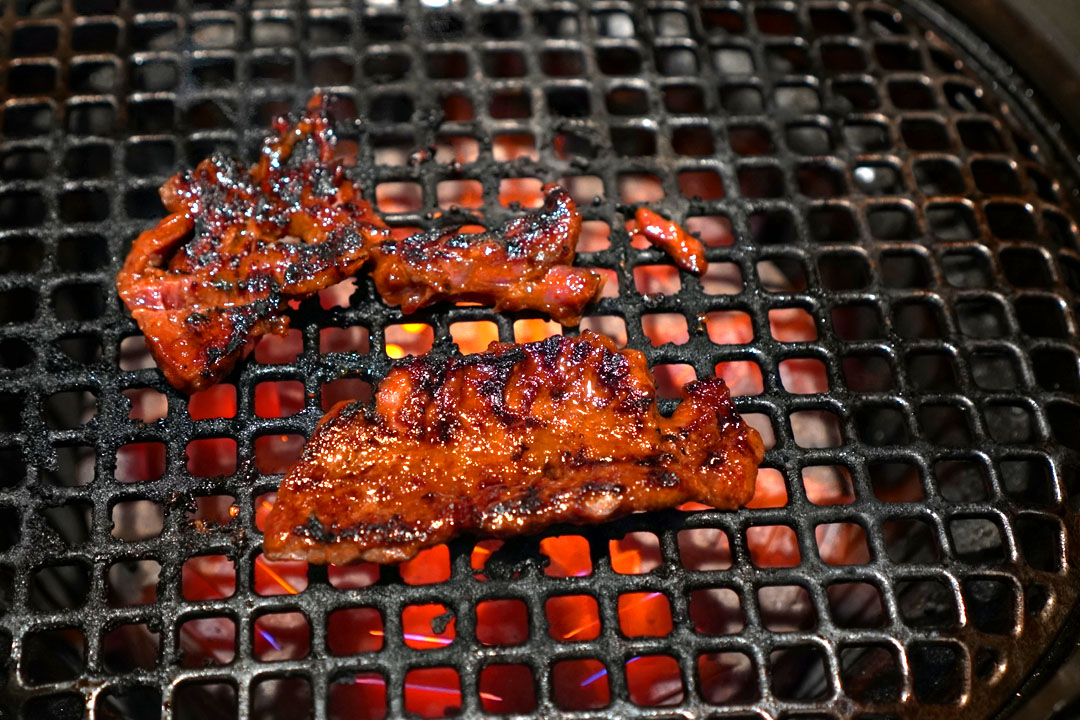
10a: Miso • US Wagyu Hanging Tender | 味噌 • US和牛サガリ
My sagari was indeed as tender as advertised, while its full-throated beefiness paired swimmingly with the generous application of sweetness and smoke.
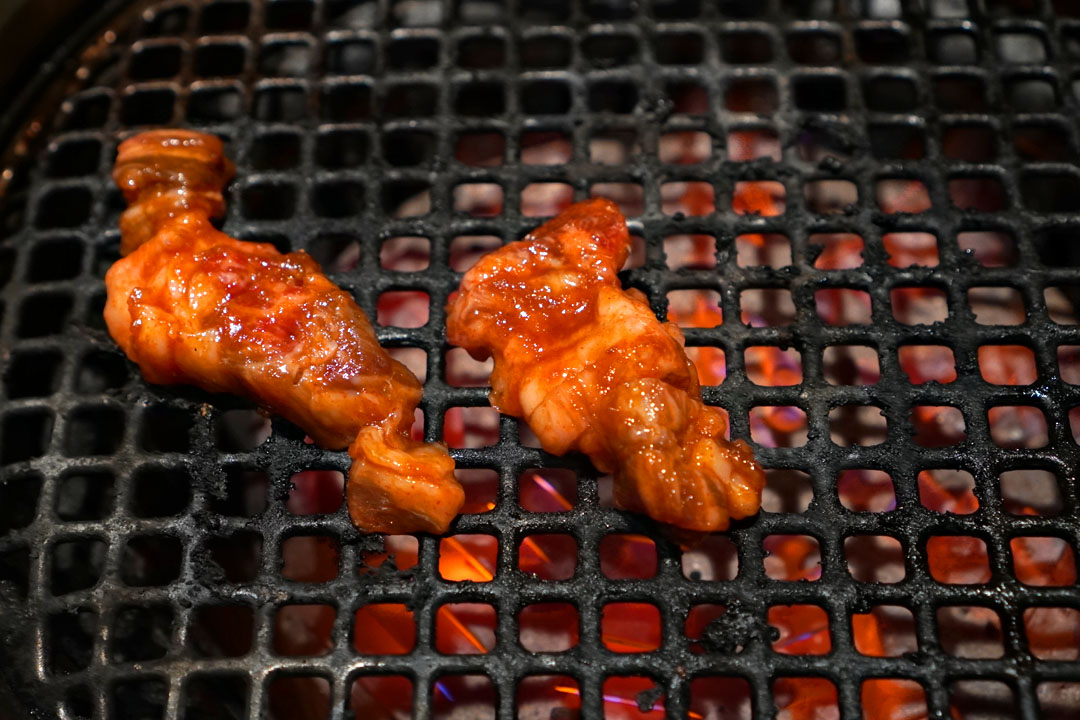
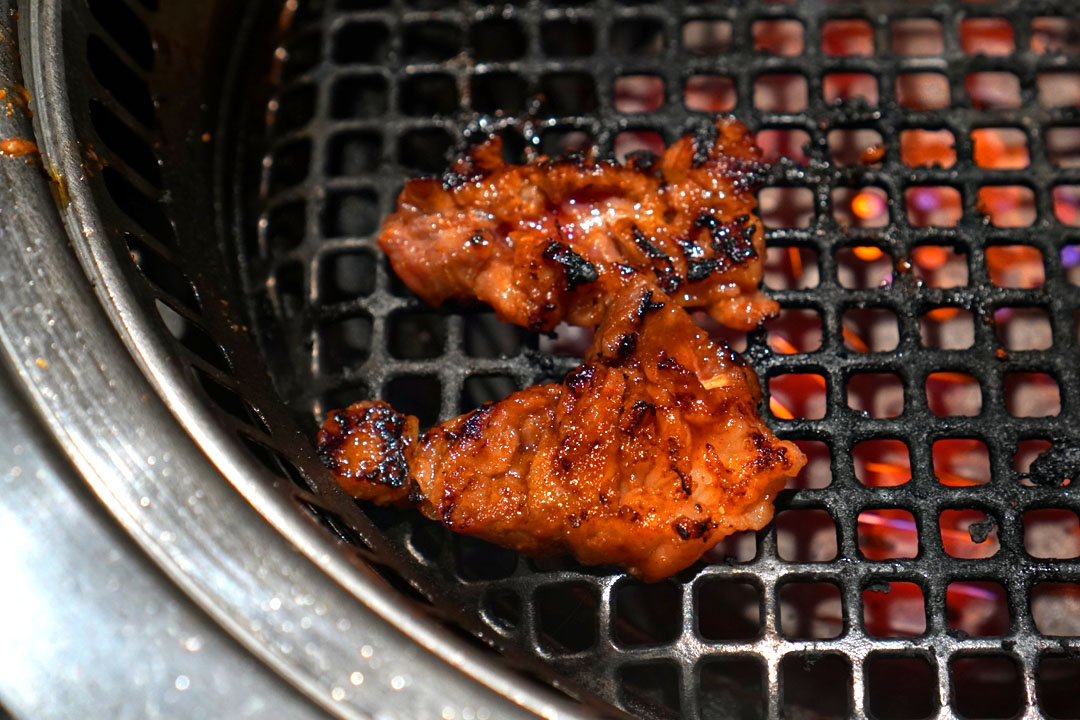
10b: Miso • Tail | 味噌 • テール
The beef tail was an interesting cut that I don't think I've encountered at yakiniku before. Not surprisingly, it was on the tougher, chewier side, with a pretty assertive taste that matched up with its robust miso marinade.
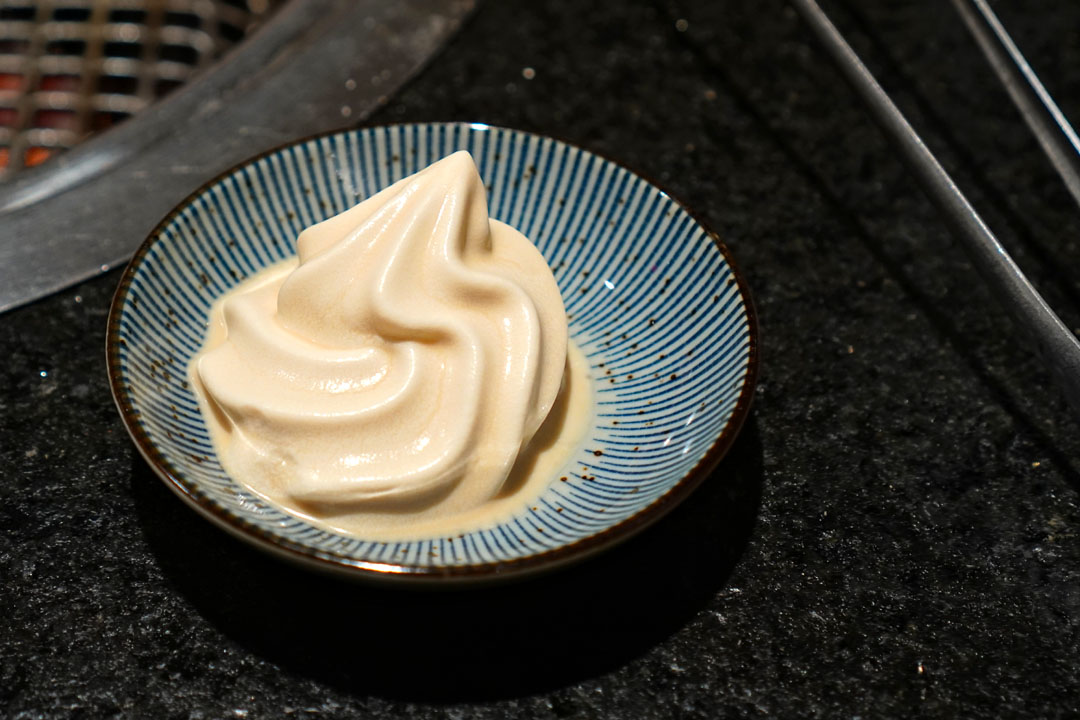

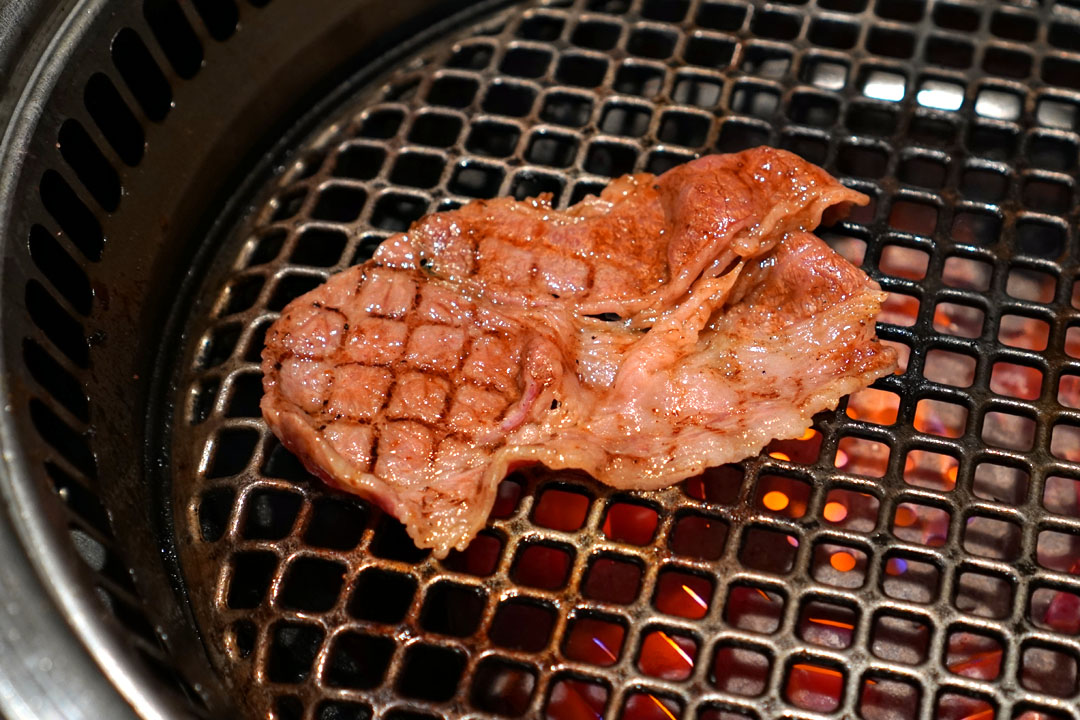
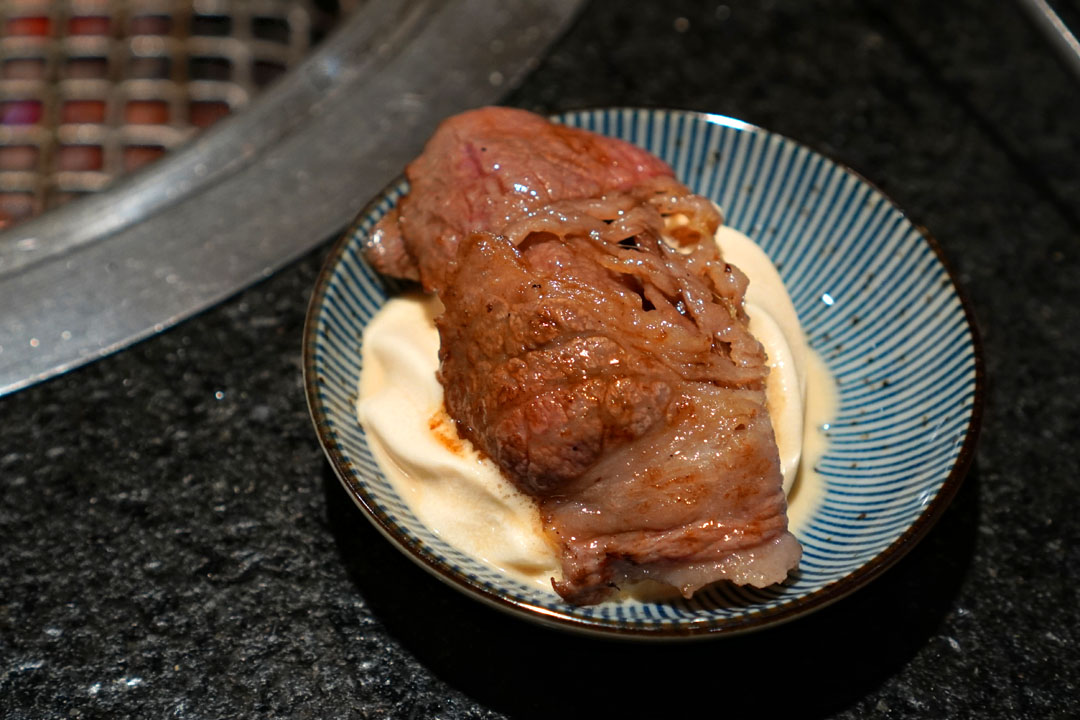
11: Sukiyaki • A5 Wagyu | すき焼き • 日本産A5和牛
Thin-cut slices of Kagoshima wagyu functioned superbly in sukiyaki duty. The beef was certainly delicious alone thanks to its abundance of sweet, savory, smoky notes, but what made this special was the use of that surprisingly airy cream, which actually resulted in some more well integrated flavors compared to your traditional egg yolk dip.
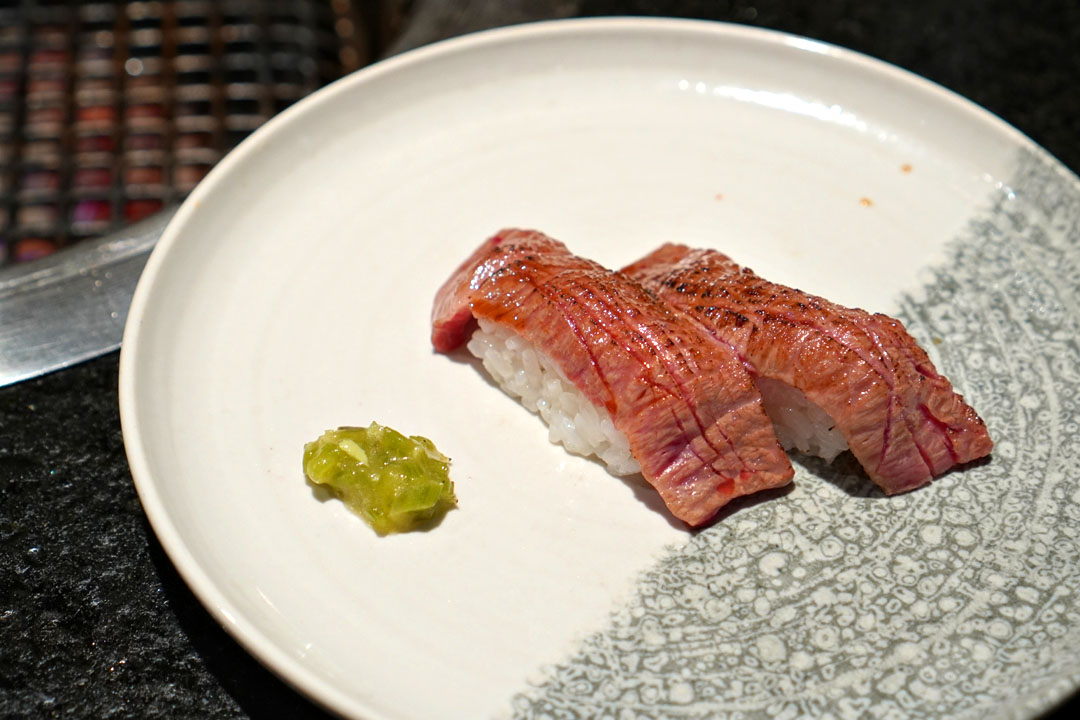
12: A5 Wagyu Sushi [$10] | A5和牛寿司
It was now time for our shime course, and we opted to upgrade from the standard miso beef rice to a prototypical presentation of seared wagyu layered over mildly-seasoned rice, with a dollop of kizami wasabi on the side.
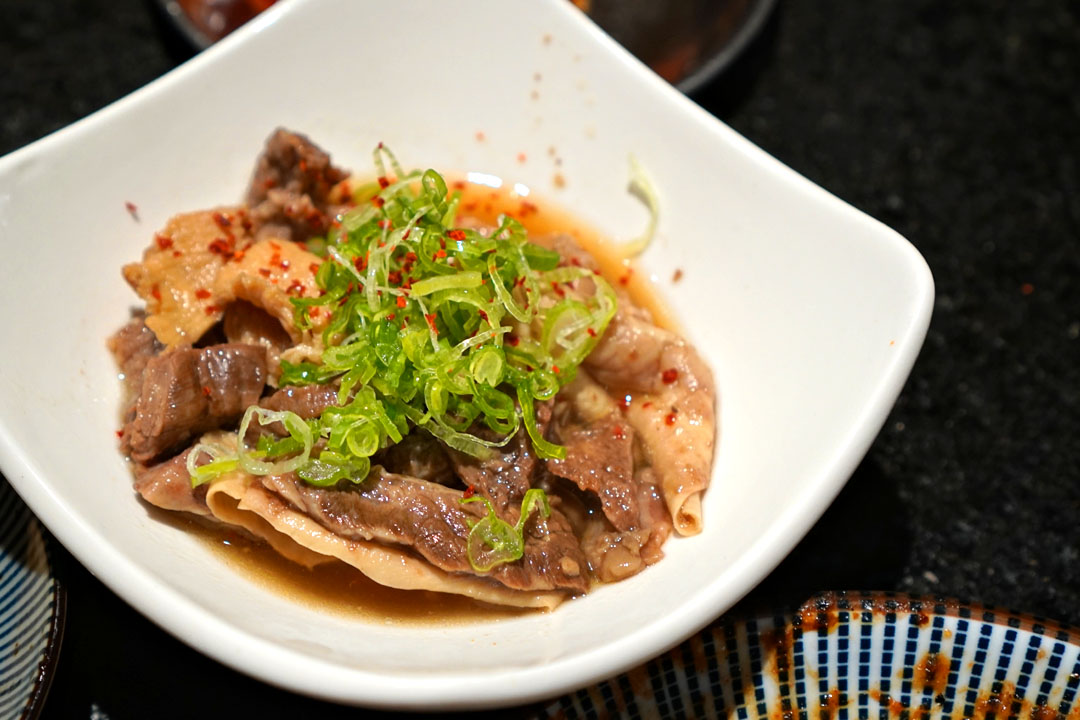
Tripe Stew [$5.00] | モツ煮
We then ordered a few supplemental items to close out the night with. The motsuni was a homey sort of dish comprised of well-textured shards of tripe set in a salty, savory broth, with the green onion working to brighten things up.
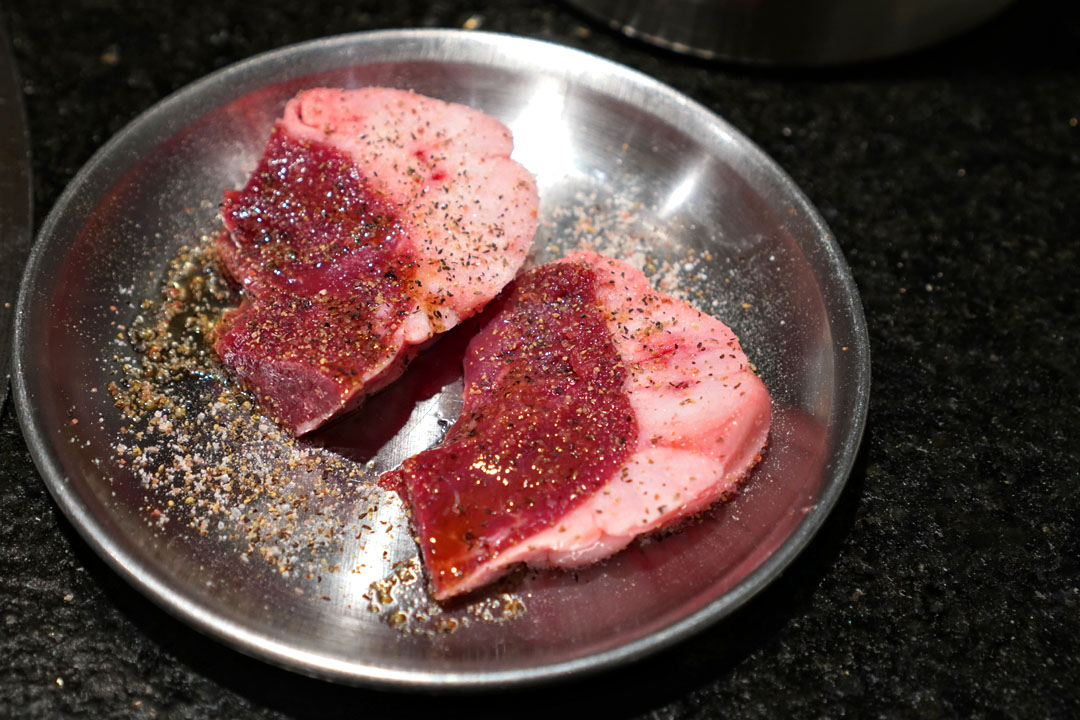
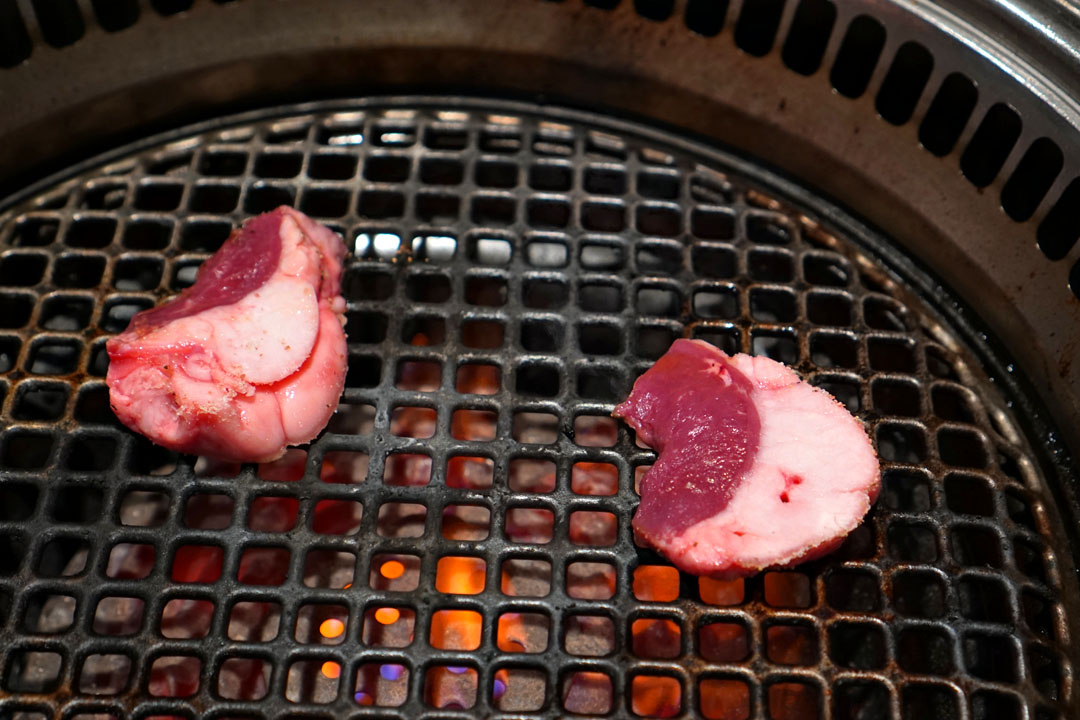
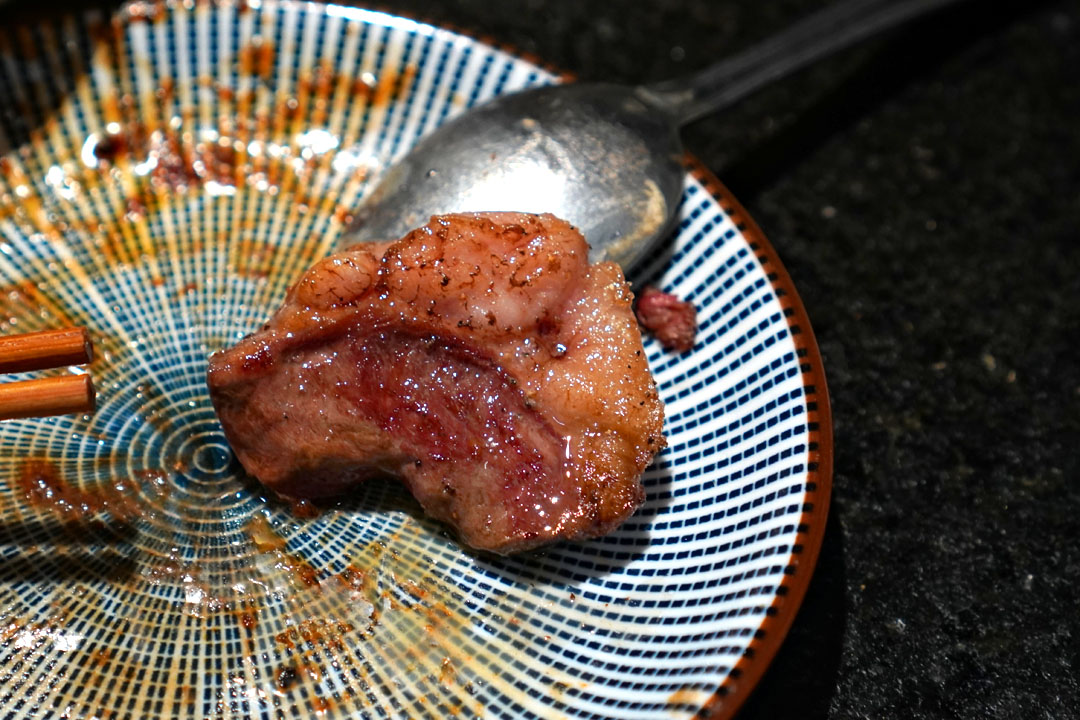
US Wagyu Premium Heart [$5.00] | 特上アブシン
Seasoned simply with salt and pepper, the tokujo abushin was unlike most beef heart I've had, as its heightened fattiness resulted in a much richer, more luscious eating experience.
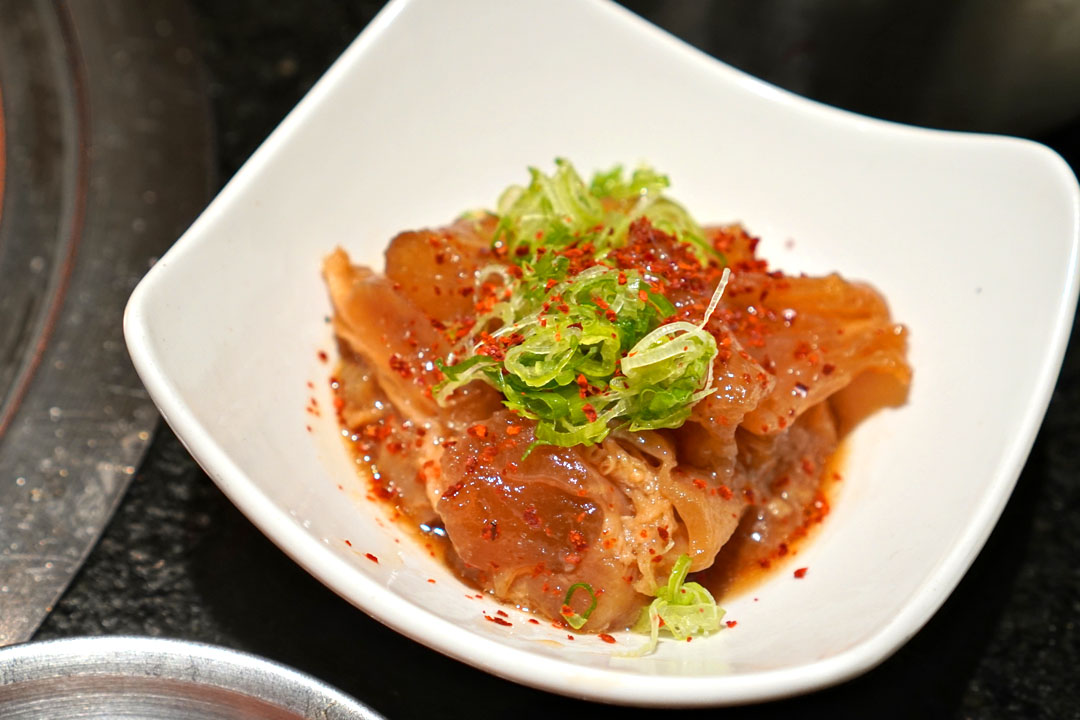
Beef Collagen Stew [$5.00] | 牛コラーゲン煮
Stewed collagen had that almost crunchy-yet-sticky consistency I was looking for, while the heat from the chilies worked hand-in-hand with the presence of negi.
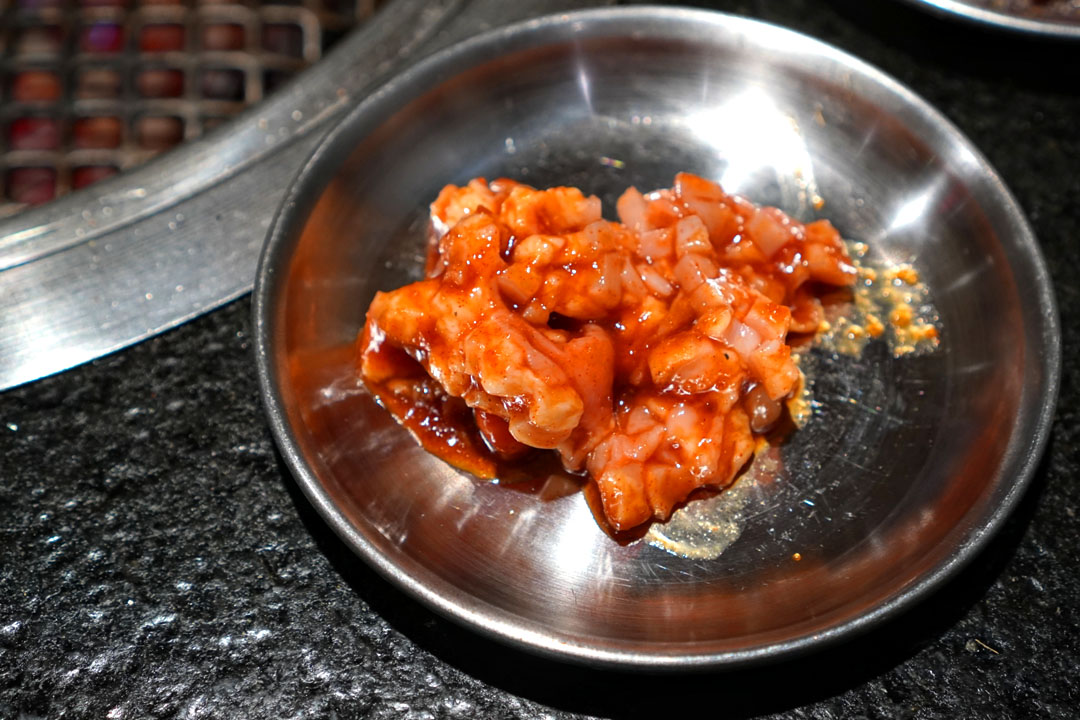

US Wagyu Abomasum [$5.00] | US和牛アカセン
Last up was the akasen, which showcased this chewy, "snappy" texture along with bountiful amounts of sweetness and smoke.
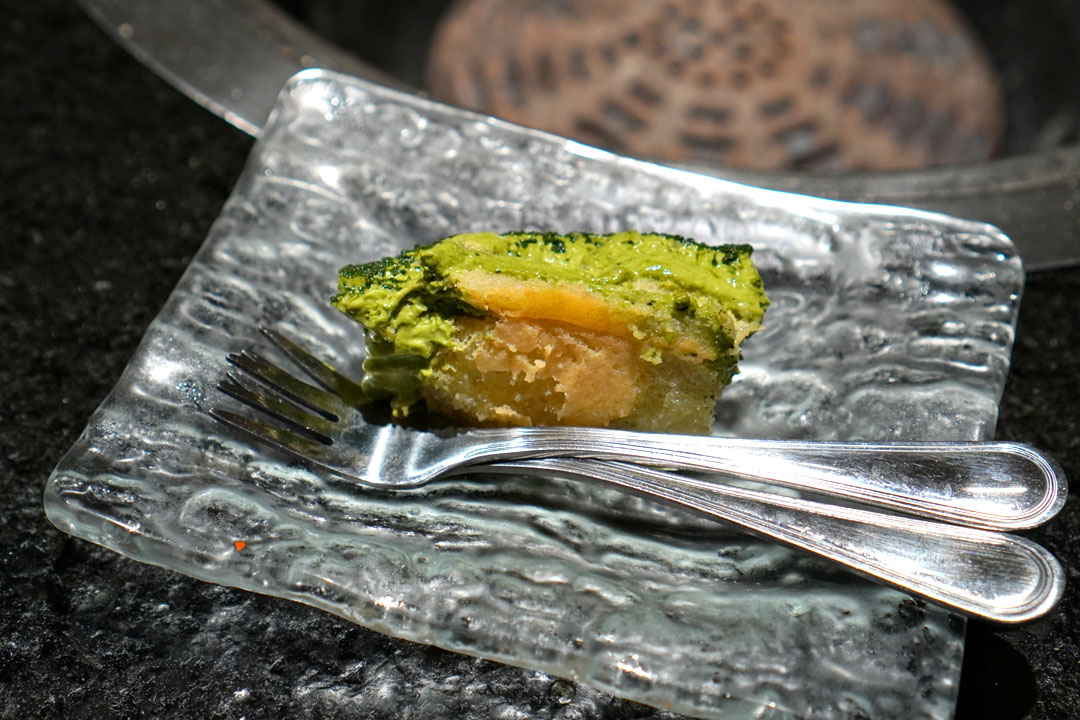
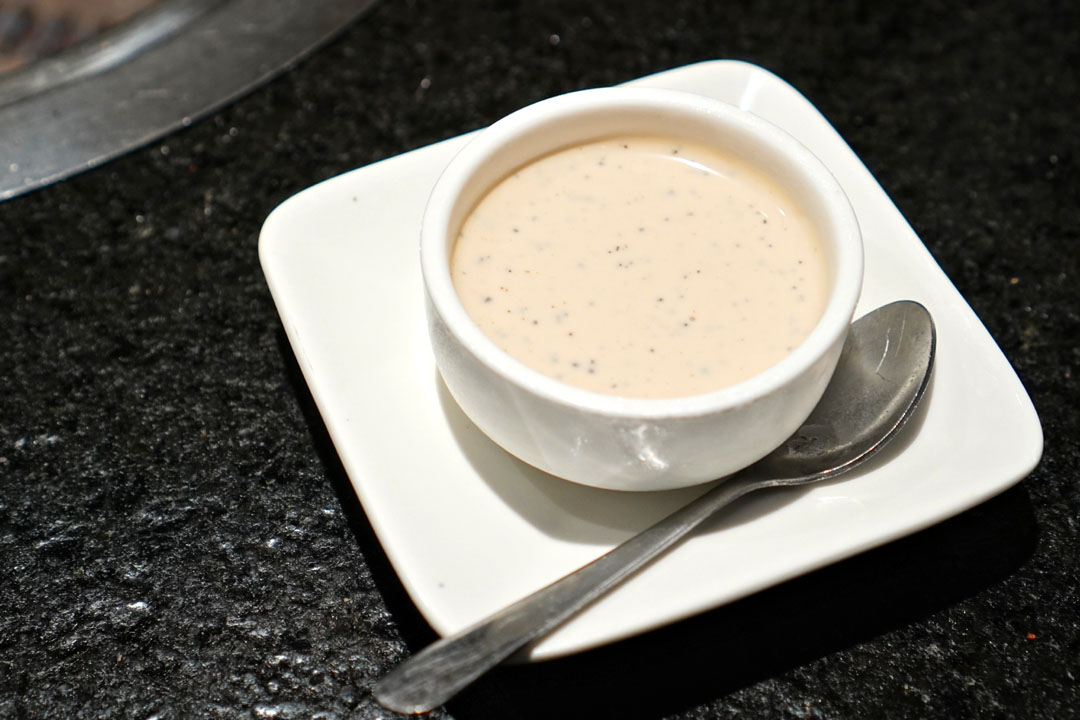
13: Today's Dessert | 今日のデザート
The standard dessert was a relatively light, creamy pudding, while the matcha tiramisu was an optional upgrade. However, we ended up being given the cake for free, as the restaurant apparently didn't have a proper piece of it left.
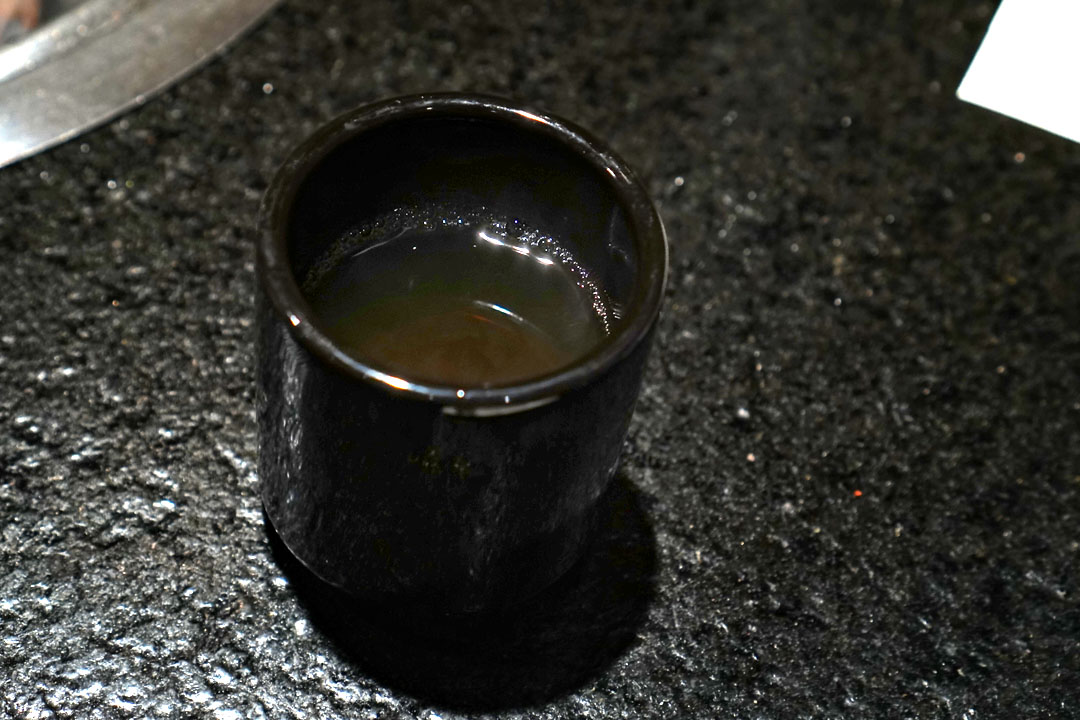
Accompanying dessert was a hot 'n' snug cup of tea.
For all you yakiniku fiends out there, Wagyu Butcher is one that you have to try. Take-san and his team have a created a unique experience, both a result of the counter-only dining situation and the omakase-focused menu, while the selection of meat and related items doesn't leave much to be desired, either. Quite simply, I don't think there's any other yakiniku spot like this in the entire Los Angeles area.
2104 Artesia Blvd, Torrance, CA 90504
310-483-1530
www.instagram.com/wagyu_butcher_la/
Sun 04/20/2025, 07:30p-10:10p

I'm always on the lookout for new yakiniku-ya, and a recent entrant into the scene is the straightforwardly-monikered Wagyu Butcher, which opened in early November last year. The restaurant is spearheaded by Toshinori Hayakawa (早川宗徳) and Takatoshi Kano (家納孝敏), alumni of the Gyu-Kaku chain and part of the leadership team at Dining Innovation, a Japanese hospitality group that operates nearly 500 eateries. To run the kitchen, they've brought on board Executive Butcher Takeshi Yamakawa, an industry veteran who operates two yakiniku spots and a yakitori-ya in Osaka.
About the Chef: Yamakawa Takeshi (山川剛史) originally hails from Fukushima, the son of rice farmers who developed an interest in food early on. After finishing high school at age 18, he moved to Osaka and attended the Tsuji Culinary Institute (辻調理師専門学校), during which time he worked at a local counter-service okonomiyaki joint and fell in love with the customer interaction aspect of running a restaurant. Following, he spent three years at a barbecue-slash-yakitori spot, and it's here where he really honed his butchery skills.
In July 2009, via his company Mochitsumotaretsu (株式会社もちつもたれつ), Yamakawa-san took over Dengeki Horumon Tsugie (電撃ホルモン ツギエ), a yakiniku restaurant in Osaka's Tenma neighborhood that was initially started in September 2007 by Genki Factory (元気ファクトリー). The tachigui-style (standing-only) eatery began gaining more and more customers, and its success allowed the Chef to open a second location by the name of Nikukurai Horumon Susumu (肉喰ホルモンすすむ) in nearby Tenroku in May 2013. This was followed by a yakitori place in Kyobashi called Akadori Haruka (赤鶏はるか) in April 2016, and from what I understand, all three businesses are still operational.

Wagyu Butcher takes over a newly-built storefront at Van Art Square, the same strip mall that's home to Hasu and Curryfornia. The restaurant comprises one large U-shaped counter surrounding the kitchen; 10 grills are installed, thus allowing up to 20 guests to dine.

Shown above is my view from the right-most seat at the bar. If you're wondering what's written on the noren, it's: 焼肉は 切りたてが 断然らまい ("freshly cut yakiniku is definitely the best").





As for Wagyu Butcher's menu, Takeshi-san offers a $70 Butcher's Omakase (ブッチャーズおまかせ) and a $50 Tenma Omakase (天満おまかせ), along with optional à la carte supplements. To drink, there's a small selection of sake, a compact wine list, a smattering of beer, and sundry variations of shochu. Corkage was $25 a pop. Click for larger versions.

1: Today's Kimchee | キムチ盛合せ
The first of four zensai courses was an assortment of kimchi. I began with the tomato, which featured this familiar, almost Chinese-y spicing that I really enjoyed. The napa cabbage was more classic in terms of taste, with a somewhat drier consistency than usual. Last up was the celery, which had its bitter, vegetal qualities well-tempered by a chile-fueled heat.

2: Today's Vegetable | ナムル盛合せ
Our namuru moriawase selection also fit the bill, and I especially enjoyed how the veggies played with the overtly nutty, sesame-powered flavors in the dish.

We BYOB'd tonight, and first to drink was the 2024 Hananoka Ubusuna Kabashiko Shinojo Namazake (花の香 産土 香子 四農醸 生酒), a kimoto-style brew from Kumamoto Prefecture, made from a recently-revived type of rice grown in the Kikuchi River basin. The sake smelled sweet and rice-forward, with a real freshness to go along with hints of minerality and white fruits. On the palate, this was fizzy and refreshing, its ricey sweetness recalling pastry dough at times while being joined by a bitter backing and a pervasive acidity. Do note that I actually drank this bottle's two sister sakes at Tonchinkan back in January, and this was probably my favorite of the three.


3: House Salad & Today's Soup | サラダ&スープ
Next came a bright, bitter salad, though one that could've used a bit more dressing. More interesting was the beef tendon soup, which paired the meat with a bevy of sweet, tangy, tomato-ish flavors.

4: Shio Beef Sashimi | 塩ユッケ
The shio yukke delivered, the mildly seasoned, slightly chewy beef melding well with the zestiness of chopped onion, all while that lemon imparted a sour twang.



5a: Lemon • US Wagyu Filet | レモン • US和牛ヘレ
At this point, it was time for the oniku portion of our dinner to commence, and up first was the hire, a supple, fine-grained cut with the classic, subdued tastes that you'd expect from tenderloin.



5b: Lemon • 3 Beef Tongues (Thin, Thick & Tongue Kalbi) | レモン • 特上牛タン3種(牛タン, 厚切りタン, タンカルビ)
Along with the filet above, we were given a trio of gyutan. I began with the atsu-kiri, which was great texturally, with an almost silky, "snappy" mouthfeel and a restrained beefiness. The standard tongue, meanwhile, showed off a more assertive consistency, along with a richer flavor profile. Finally, the karubi was the most unexpected of the threesome. Taken from the underside of the tongue, it was easily the chewiest of the bunch, but also the saltiest and the savoriest.




6: Ponzu • US Wagyu Chuck Flap | ポン酢 • US和牛ロース
The rosu was perhaps the most balanced cut of beef we had tonight, both in terms of taste and texture, and made a whole lotta sense with a dip into that tangy ponzu.




7: Sweet Soy • US Prime Short Rib | タレ • 特上カルビ
The tokujo karubi displayed a bit of chew, and definitely possessed a palpable sweetness, but fortunately one that never got overwhelming. The galbi was accompanied by two types of tare. The Tokyo-style was meant to be sweeter, and seemingly emphasized the smokiness of the beef. On the other hand, the Osaka-style sauce was described as being saltier, and appeared to highlight the interplay between the sweetness of the meat and the green onion.



8: Sweet Soy • US Prime Outside Skirt | タレ • 特上ハラミ
Our tokujo harami was probably the most intriguing cut of the night in terms of texture, while the skirt steak's sophisticated display of umami was joined by a slight sweetness that I didn't mind.



9a: Miso • US Wagyu Inside Skirt | 味噌 • US和牛兄弟ハラミ
Compared to the skirt steak above, the kyodai harami was an altogether different experience: a much fattier, chewier cut with a more apparent, miso-boosted sweetness.



9b: Miso • Large Intestine | 味噌 • ホルモン(大腸)
The daicho marked the first appearance of horumon in our meal. The offal demonstrated an agreeably tender-yet-chewy texture, while its sweetness married well with all the smoke and sear happening.

The evening's second BYO bottle was the 2018 Amuse Bouche, a Pomerol-inspired Napa Valley red blend comprised of 92% Merlot and 8% Cabernet Franc. On the nose, the wine conveyed an amalgam of jammy berries and blue fruits, overarched by layers of florals and hints of baking spice. Taking a sip, I found this on the rounder side, its plethora of cool, dark berry notes countered by mineral elements and traces of peppery spice. An apt pairing to all the meat we were having, to be sure.



10a: Miso • US Wagyu Hanging Tender | 味噌 • US和牛サガリ
My sagari was indeed as tender as advertised, while its full-throated beefiness paired swimmingly with the generous application of sweetness and smoke.


10b: Miso • Tail | 味噌 • テール
The beef tail was an interesting cut that I don't think I've encountered at yakiniku before. Not surprisingly, it was on the tougher, chewier side, with a pretty assertive taste that matched up with its robust miso marinade.




11: Sukiyaki • A5 Wagyu | すき焼き • 日本産A5和牛
Thin-cut slices of Kagoshima wagyu functioned superbly in sukiyaki duty. The beef was certainly delicious alone thanks to its abundance of sweet, savory, smoky notes, but what made this special was the use of that surprisingly airy cream, which actually resulted in some more well integrated flavors compared to your traditional egg yolk dip.

12: A5 Wagyu Sushi [$10] | A5和牛寿司
It was now time for our shime course, and we opted to upgrade from the standard miso beef rice to a prototypical presentation of seared wagyu layered over mildly-seasoned rice, with a dollop of kizami wasabi on the side.

Tripe Stew [$5.00] | モツ煮
We then ordered a few supplemental items to close out the night with. The motsuni was a homey sort of dish comprised of well-textured shards of tripe set in a salty, savory broth, with the green onion working to brighten things up.



US Wagyu Premium Heart [$5.00] | 特上アブシン
Seasoned simply with salt and pepper, the tokujo abushin was unlike most beef heart I've had, as its heightened fattiness resulted in a much richer, more luscious eating experience.

Beef Collagen Stew [$5.00] | 牛コラーゲン煮
Stewed collagen had that almost crunchy-yet-sticky consistency I was looking for, while the heat from the chilies worked hand-in-hand with the presence of negi.


US Wagyu Abomasum [$5.00] | US和牛アカセン
Last up was the akasen, which showcased this chewy, "snappy" texture along with bountiful amounts of sweetness and smoke.


13: Today's Dessert | 今日のデザート
The standard dessert was a relatively light, creamy pudding, while the matcha tiramisu was an optional upgrade. However, we ended up being given the cake for free, as the restaurant apparently didn't have a proper piece of it left.

Accompanying dessert was a hot 'n' snug cup of tea.
For all you yakiniku fiends out there, Wagyu Butcher is one that you have to try. Take-san and his team have a created a unique experience, both a result of the counter-only dining situation and the omakase-focused menu, while the selection of meat and related items doesn't leave much to be desired, either. Quite simply, I don't think there's any other yakiniku spot like this in the entire Los Angeles area.
4 Comments:
Wonderful, a spot close to home! I want to check it out, but so many other interesting spots for now. I haven't visited your blog in a little while, glad to still see new and interesting spots in your rotation Kev.
Now you've got me curious--what are some other interesting spots around the South Bay that I should be checking out?
There’s not much I could recommend in the South Bay that’s on the caliber of most of the stuff on your blog other than Sonagi and Inaba, since given the history of the South Bay a lot of the spots are extremely old school or homey Japanese. I’m going to range all over here.
Some extremely lowkey picks:
Fukugawa - they do Japanese breakfast here, which is pretty rare in the states. I see a lot of locals or people speaking Japanese whenever I’m here. Nothing fancy, just typical authentic food done right.
The “best” conveyor belt sushi is Waka Sakura in Tokyo Central. Inexpensive and fun, not very serious sushi. Uses red vinegar so the rice looks more brown. Beef trio is actually pretty delicious. Go early to put name down so you don’t have to wait. Closest we've had to the same conveyor belt experience outside of Japan.
Sakae Sushi, call in order in advance, perfect for takeout to picnic on the beach, Joshua Tree/day trips, or just bringing to a potluck party. LA times wrote an article on the shop.
If you ever need an omiyage or gift, I like to get a few pieces of mochi from Chikara. Go early or the beautiful pieces will be gone.
Ojiya - another fun place, it reminds me of the izakayas in Japan a lot. Also see lots of locals/japanese speakers here.
Gaburi Chicken - newish chain from Nagoya, fun little casual spot with friends to share little things and drinks together.
Grocery
Meiji Tofu - perfect for when you need to make mapo or anything where the tofu gets to shine, like shabu shabu. I think I’ve seen you have had it before on your blog at some restaurant?
Kansha Creamery - a little icy, a little annoying to get to a few years ago, but they might be doing better with inventory management these days. Unique or typical Asian ice cream flavors. I've been annoyed by the constant price increases and fomo-style ordering a few years ago. One time a giant roach walked on my foot and they couldn't have cared less and that really ruined the shop for me. However whenever I drive by I still see long lines and it's beloved by the locals. I have a chip on my shoulder lol.
Haven’t been, but on the list for sometime: Torachan or Manpuku, 92Kbbq, Ueno Sushi, The Neon Sun
Offbeat Picks - again, none of these are fancy and span everywhere
Tendon Carlos Junior - tempura, think you’ve already been
Taishi Hainan Chicken - it’s nothing fancy. The scallion oil sauce is a little different than the Chinese/Taiwanese versions I’m used to. Love the soup here for when I'm sick.
Banadir Somalian - can’t say I’ve had Somalian often but the soup and goat were comforting. Small fam business.
Yeems Coffee - the signature cloud coffee is great. Preorder if you can. Hottest new coffeeshop in town.
Wooga Seollongtang - not as good as Sulga in Ktown but for being mere minutes from home it hits the spot.
Sister restaurants Sweet Rice (their khao soi is pretty good) and Bowl Thai next door (for noodle/meat dishes).
Al Noor - Indi/Paki food that’s fantastic. Haven’t been in a while so no idea what it’s like now.
Fatto a Mano - Italian in Long Beach that’s pretty authentic. The owner is really obnoxious/helicoptery in-person and on Yelp. We usually get takeout or buy their fresh pasta to go to avoid him.
La Espanola Meats - we usually buy things here to make dinner or charcuterie boards to bring to dinner parties. Depending on the lady making it, the bocadillos are decent easy pick me ups when we’re running around doing errands. They have paella on the weekends that you need to preorder in the week; we’ve never tried it. I don’t know if they still do this, but my god during christmastime the owners would free flow iberico and wine samples in-store.
Kimbap Paradise - another pick of my friend group to grab stuff for picnics or day trips at parks. Not fancy, just an easy takeout option without going to Hmart.
Hope I was able to pick some things you haven't had before!
Great recommendations--thanks Cindy! There are actually a few spots that were already in my Excel spreadsheet of places to try, but plenty more that I had to add to the file.
Post a Comment
Subscribe to Post Comments [Atom]
<< Home